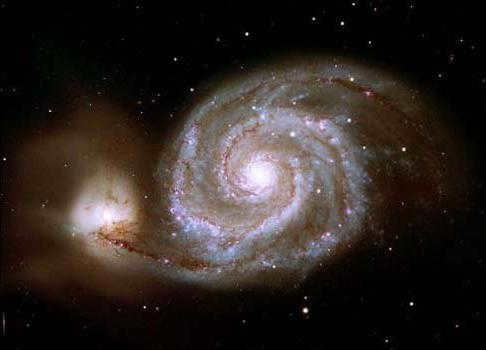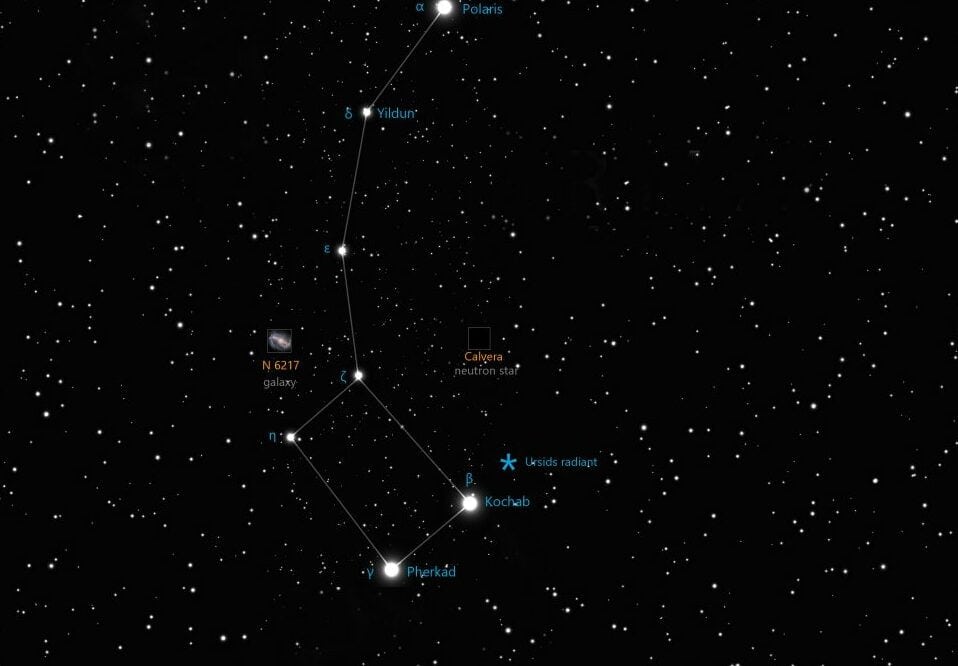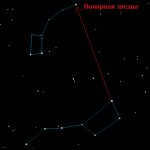
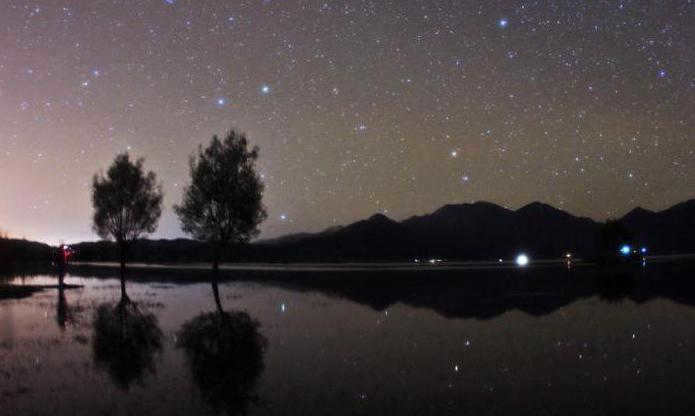
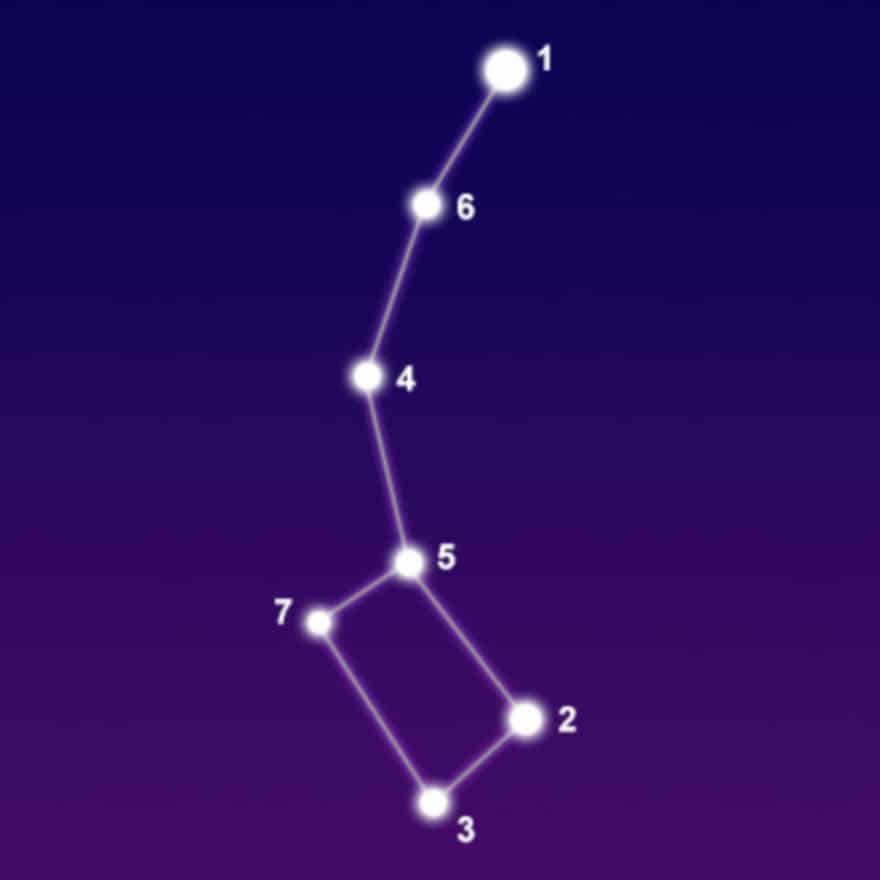
In the skies of the Northern Hemisphere, there exists a splendid constellation known as the Little Bear. It serves as the “younger sibling” to the most well-known part of the universe – the Big Dipper.
Comprising the constellations of the Big and Little Dipper.
Currently, Polaris is located here. However, it is predicted that this will change in less than a century. This is due to the Earth’s axis precession.
It is important to mention that the Little Bear constellation is situated close to the North Pole and is easily observable. Despite its small size, it is actually the 56th largest constellation. In fact, it only occupies an area of 256 square degrees.
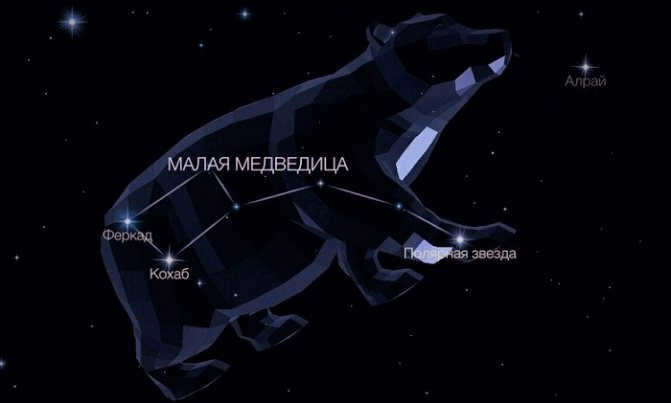
The Little Bear constellation can be located by following these steps:
How can one locate the Little Bear constellation?
Meanwhile, finding the constellation is quite easy thanks to the impressive landmark known as the Big Dipper. The key is to escape the city lights and find a spot in the depths of a park, for instance. The first step is to locate the Big Bucket asterism and its two outermost stars, Dubhe and Meraka. These stars should be connected by a line, which should then be extended behind Dubhe. When the length of this imaginary straight line is equivalent to five times the distance between Dubhe and Merak, the line will intersect with Polaris, situated at the very end of the Little Bear’s tail. The other stars veer away from Polaris in a downward arc and lead to the Little Bucket asterism.
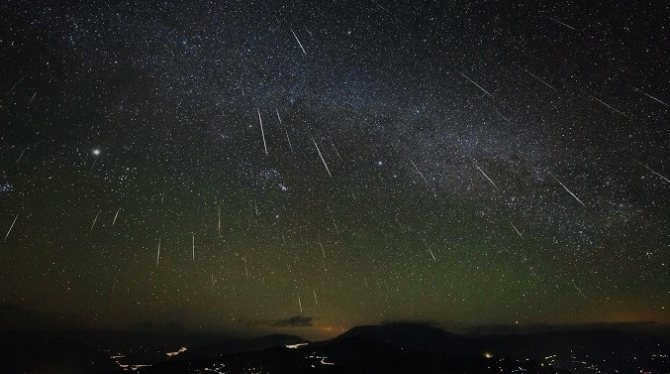
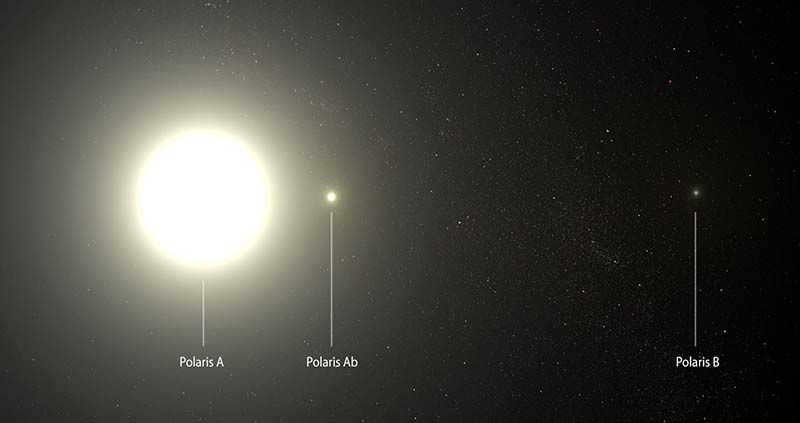
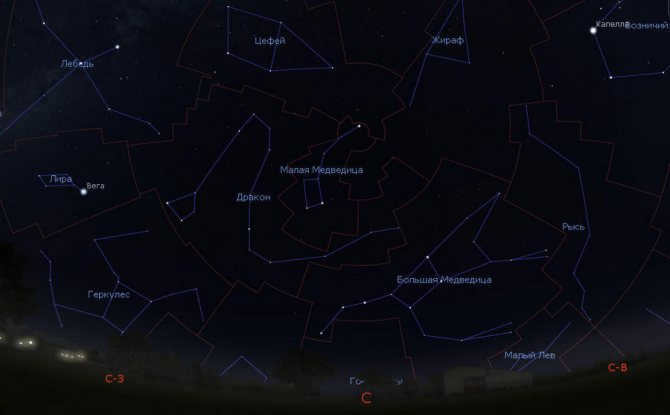
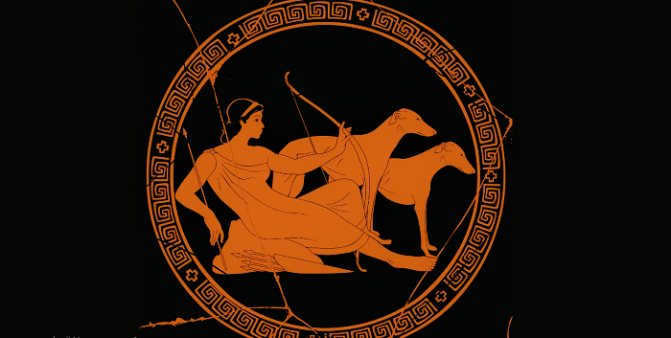
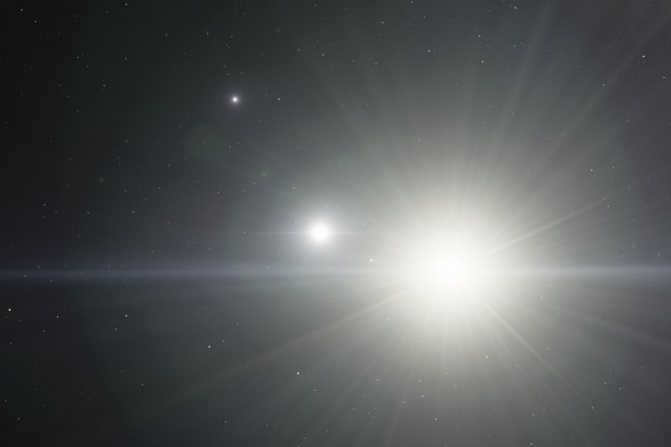
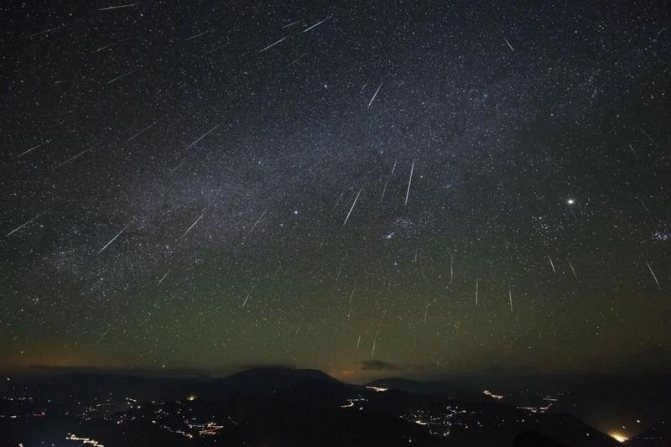
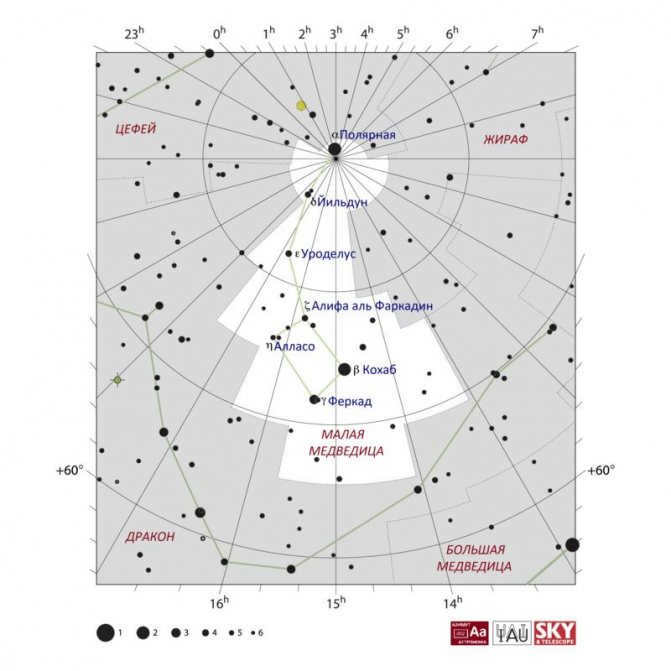
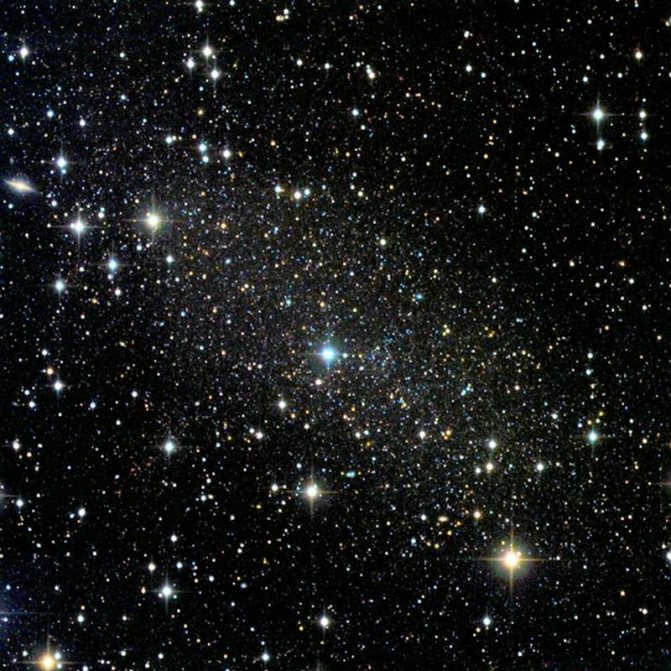
Description
The objective of this brief article is to provide a comprehensive overview of the content that follows. In the subsequent sections, we will delve into the details and intricacies of the subject matter, presenting a thorough analysis and examination of the topic at hand. This article aims to offer valuable insights and information, shedding light on various aspects and perspectives related to the subject. By the end of this piece, readers will have a clear understanding and grasp of the discussed subject, equipping them with knowledge and understanding that can be applied in various contexts and situations.
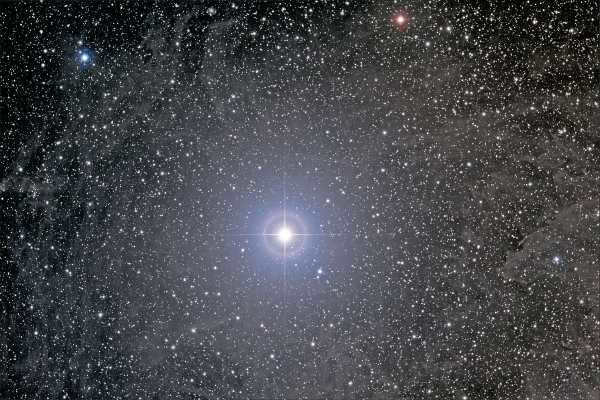
An image of the nebula surrounding Polaris captured using extended exposure times.
The physical attributes of this supergiant are fairly typical. When observed through a small telescope or even binoculars, the star appears yellow in color, which may come as a surprise to some as it is commonly believed to be white. The star’s temperature is only slightly hotter than our Sun, measuring around 6000 K. However, the similarities end there.
Similar to numerous other suns visible to the naked eye in the sky, Polaris is more luminous than the Sun when observed from an equidistant point. Analysis of its spectral characteristics has revealed its classification as a supergiant. With a diameter 23 times larger than our Sun and a luminosity 2500 times more intense, Polaris easily surpasses even Sirius in radiance.
Astrological Significance of the Little Bear
Although the Little Bear constellation may seem small and insignificant, it has garnered much attention in both scientific and fictional works. Covering just 256 square degrees, it ranks fifty-sixth out of the eighty-eight constellations. Its ancient origins can be traced back to Ptolemy’s “Almagest”, which explains its enduring popularity.
What is the cause behind this phenomenon? The explanation can be found in the primary star that embellishes the Little Bear constellation. Polaris has been the center of attention for humans throughout history. Despite its lesser brightness compared to notable stars like Sirius or Vega, it is Polaris that has secured the fame of the Little Bear.
The stars comprising the Bucket Cluster
Now, let’s shift our focus to the Big Dipper constellation. It is simply inconceivable to envision the realm of outer space without this prominent celestial formation. Within this stellar assemblage, we find:
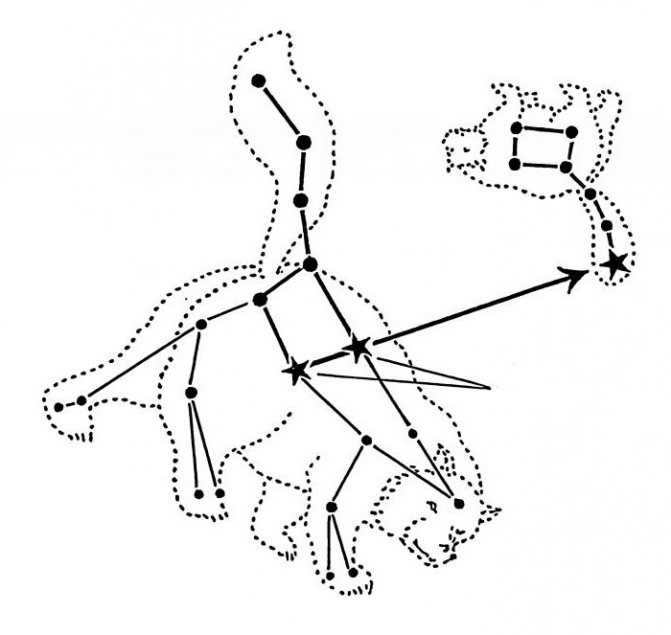
The star known as Dubhe is commonly referred to as “bear” due to its translation. It holds the distinction of being the brightest star within the Big Dipper constellation. Merak, the second brightest star, is named for its translation meaning “loins.” Fekda, which means “thigh,” is another star in this cluster. Megretz, referred to as “beginning of the tail,” and Aliot, translated as “curd,” are also part of this constellation. Mitzar, known as “loincloth,” and Benetnash, which literally translates to “leader of the mourners,” are additional stars that make up this known cluster.
These are just a few examples of the many stars that together form this well-known constellation.
Geographical Position
The reason behind the popularity of Polaris is its close proximity to the North Pole. This particular star, which is located in the constellation of Ursa Minor, is only one degree away from it. Furthermore, due to the Earth’s axis precession, by the year 2100, it will move even closer by half a degree. It gives an illusion of floating above the North Pole. In the past, explorers used its location to determine the cardinal directions, and the altitude of the Pole Star above the horizon helped them determine their geographic latitude.
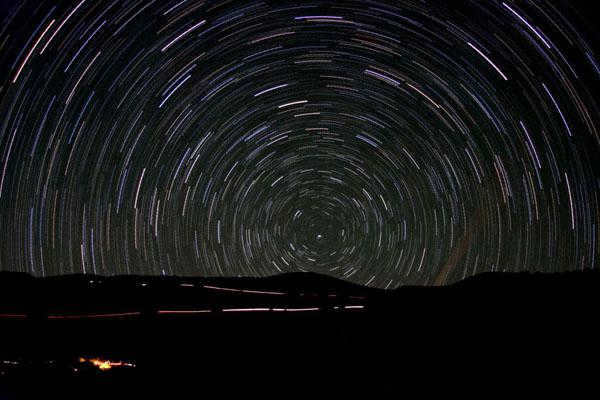
The North Pole is where the Earth’s axis extends and rests. The stars found in this region seem to be still to someone observing from our planet’s surface. Since approximately 1100, Polaris has been the star that the rest revolve around. In the future, it will be replaced by a different star after 3200.
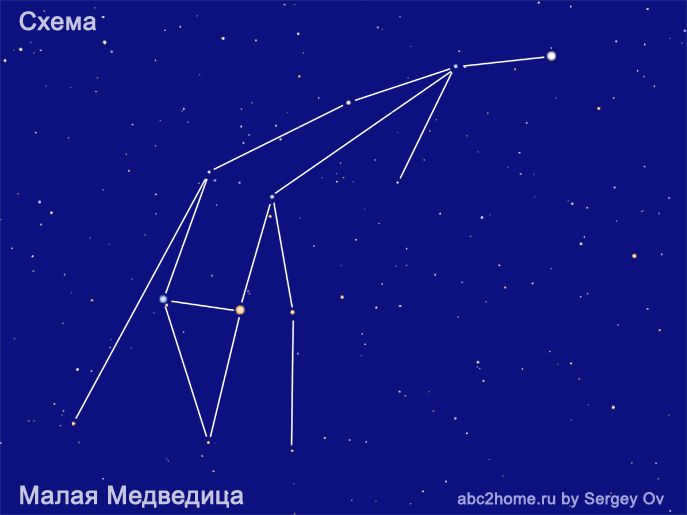
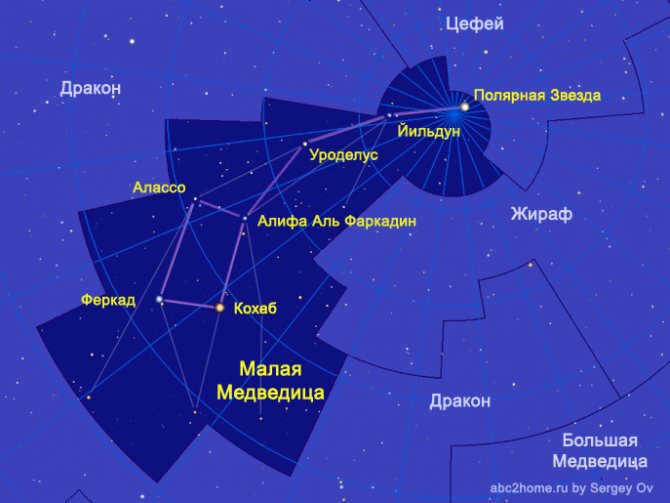
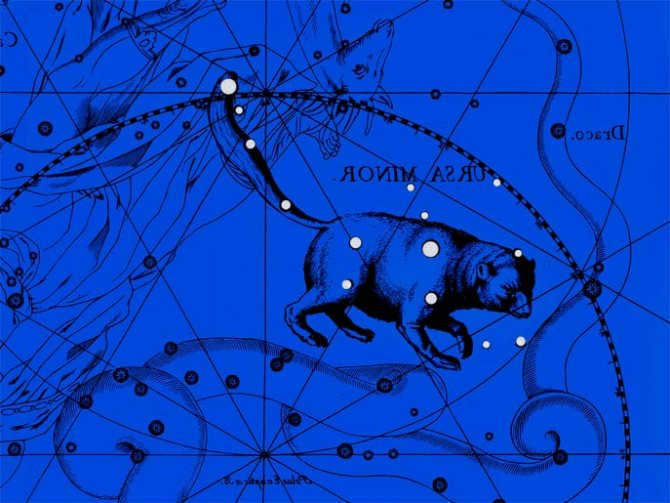
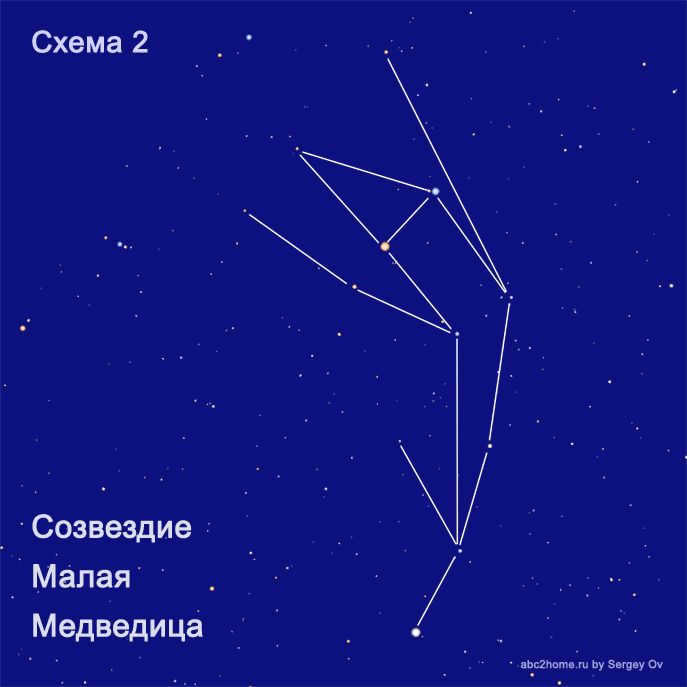
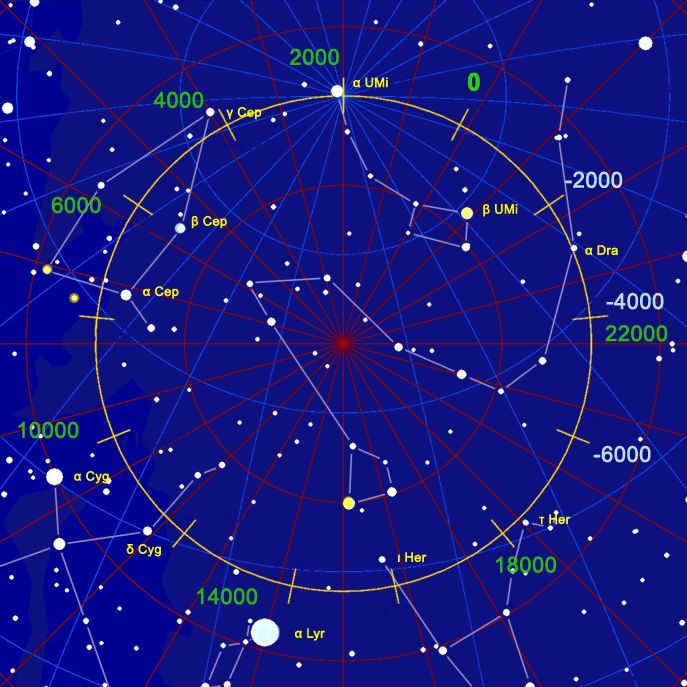
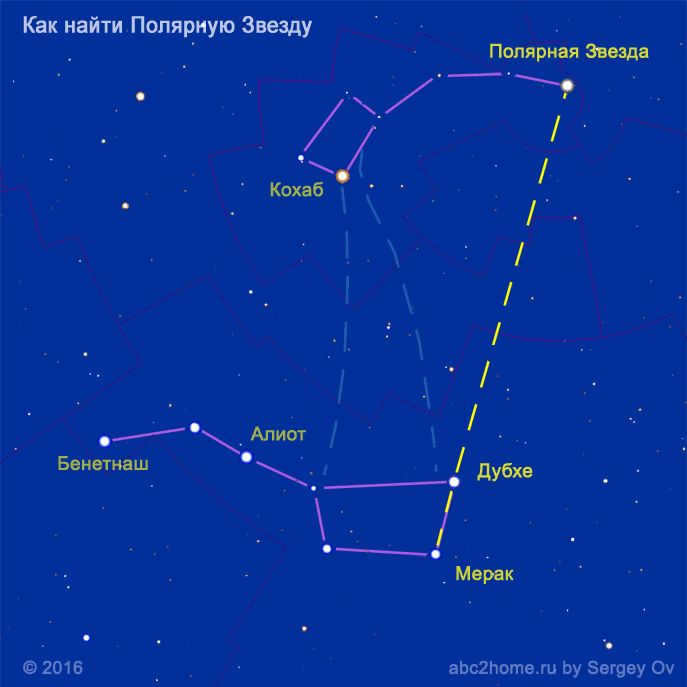
Fascinating items
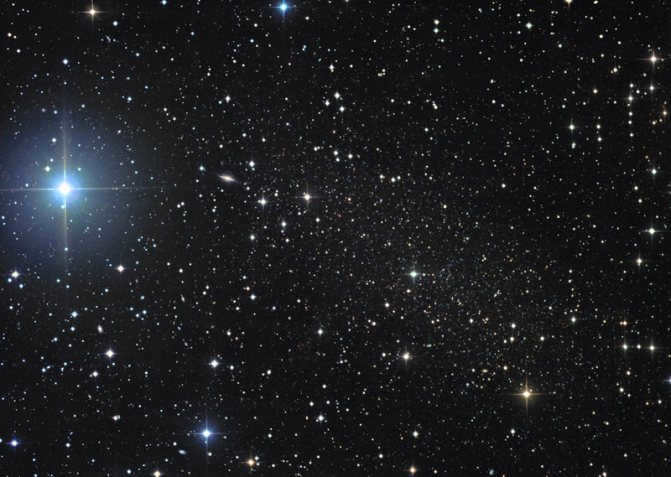
The Small Dwarf Galaxy in the Constellation of Ursa Minor
Aside from the primary stars, the galaxies found in Ursa Minor are of particular interest. The aforementioned Dwarf galaxy, which is a companion to the Milky Way, was first discovered in 1954. It is an ancient galaxy, estimated to be at least ten billion years old. Due to its size, it is difficult to ascertain whether it contains any gas, dust, or ongoing star formation processes. Sometimes, it is referred to as Polarissima due to its proximity to the Earth’s axis of rotation.
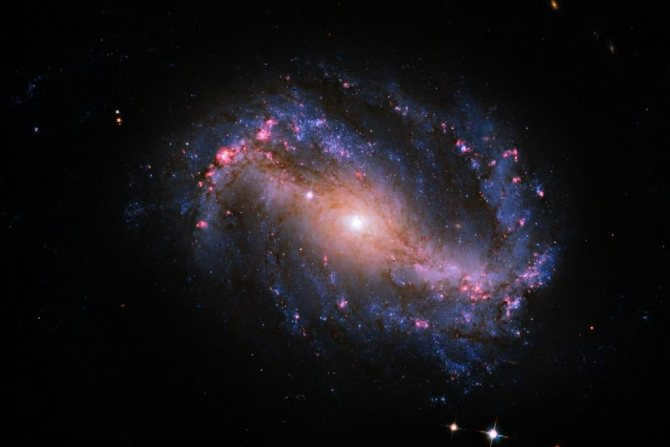
Furthermore, there are also NGC 6217 and NGC 5832 galaxies in the constellation. All of these celestial objects are relatively small on a cosmic scale, making it impossible to observe them without the aid of high-quality optical equipment.
Physical characteristics
Polaris is of great interest to scientists for various reasons. It is a triple system, with Polaris A being a supergiant that is two thousand times brighter than the Sun. Polaris Ab is its closest companion, located just eighteen and a half astronomical units away from the supergiant and remaining unnoticed for a long time. Polaris B is the third companion, situated at a significant distance from the double system and orbiting it once every thirty years.
Furthermore, Polaris, or more specifically the primary element of the system, is classified as a Cepheid variable star, which are stars that undergo changes in size and luminosity over a specific period of time. For Alpha of the Little Bear, this period is 3.97 days. This cepheid has a unique characteristic of pulsation damping and an increase in brightness, with a fifteen percent rise in luminosity.
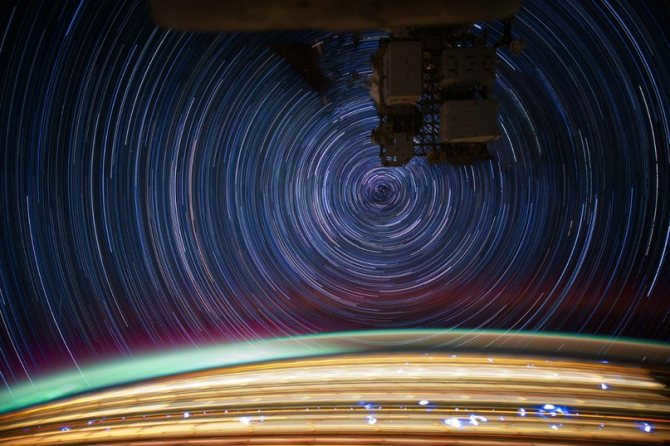
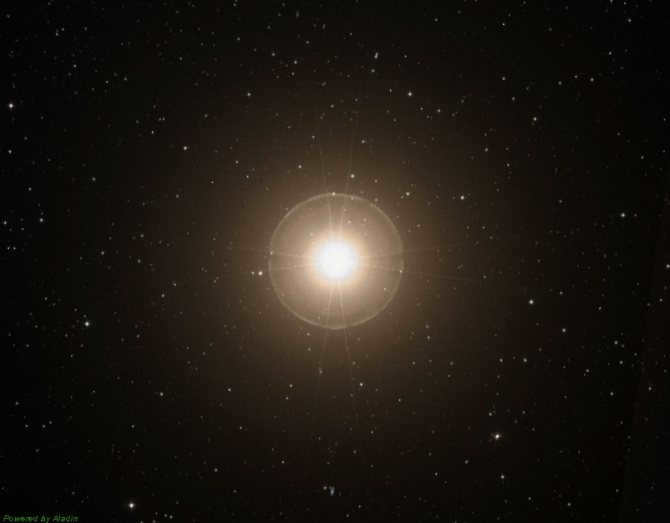
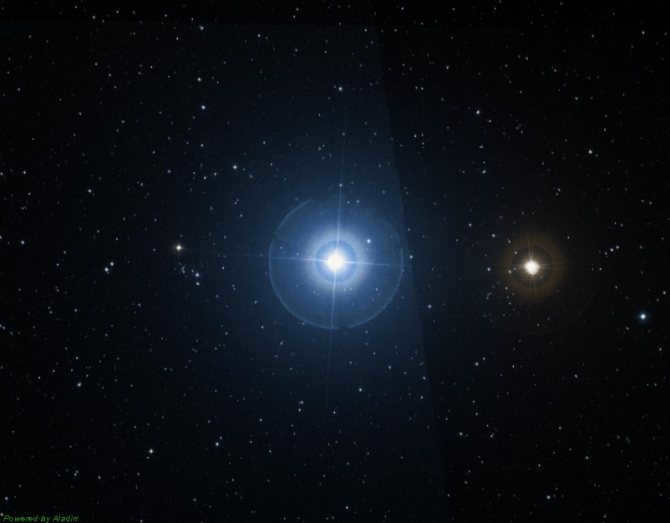
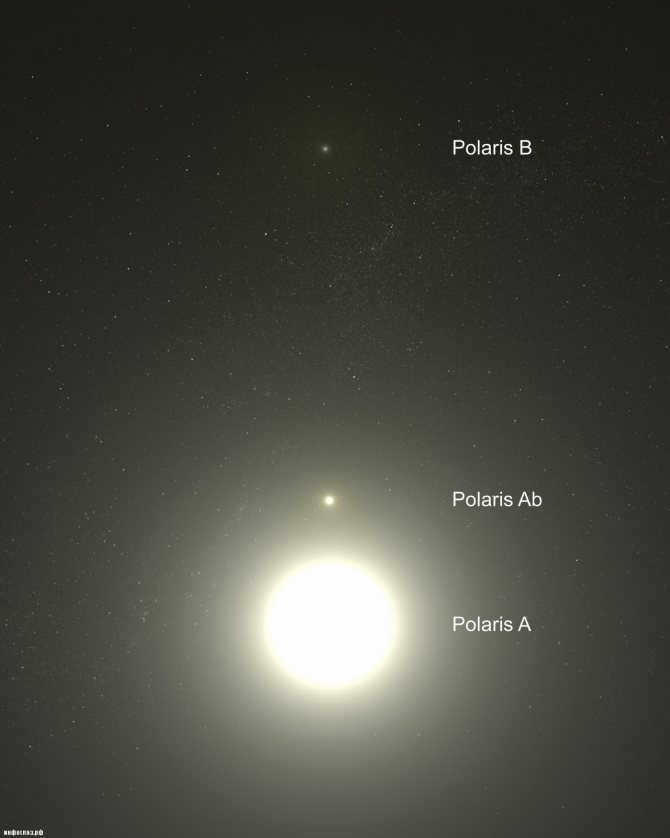
As progress advances, the enigmatic allure has vanished
Throughout history and in the modern era, constellations have served as guides for us in navigating through space. Explorers and seafarers have been able to determine the time based on the brightness and position of constellations, as well as find their way. However, nowadays, we rarely gather around the campfire and gaze at the mysterious, starry sky, nor do we create legends about the Big and Little Dippers, Cassiopeia, or Canes Venatici. Only a few individuals can now point out the constellations of the Big and Little Dipper. Our knowledge from astronomy lessons tells us that the stars are incredibly distant and that most of them are similar to our own Sun.
The development of optical telescopes has resulted in numerous discoveries that our ancestors could not comprehend. Indeed, humans have even been able to venture to the Moon, collect samples of lunar soil, and successfully return. Science has dispelled the veil of ambiguity and enigma that shrouded the celestial luminaries for centuries. Yet, we still surreptitiously gaze at the heavens, seeking out specific constellations and perceiving not just cold stars, but a snow-white Bear, a stern Leo, or a creeping Cancer traversing the celestial plane. This is why many individuals enjoy marveling at the cloudless night sky, where they can clearly observe a multitude of luminaries, their combinations, and clusters.
Systems of planets
The constellation Ursa Minor is a celestial formation containing numerous bright stars, and it is also where exoplanets have been detected. In addition to the well-known star Kohab, there are several other fainter stars in this constellation. The 11th exoplanet of Ursa Minor is situated around 390 light-years away from Earth. This particular exoplanet is categorized as an orange giant in the later stages of its life cycle. Its size is equivalent to 24 times that of our Sun, while its mass is merely 1.8 times that of our own star. In the year 2009, astronomers discovered a planet orbiting this star, completing one revolution every 516 days. The estimated mass of this planet is approximately 10.5 times that of Jupiter.
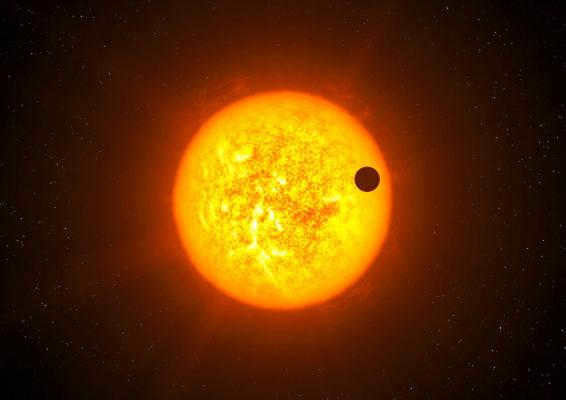
Astronomers have identified another celestial body in the constellation of the Little Bear. This star, known as HD 150706, is located at a distance of 100 light-years from Earth. Scientists believe that there is a planet orbiting this star, which takes almost six thousand days to complete one revolution around its host star.
Meteor showers
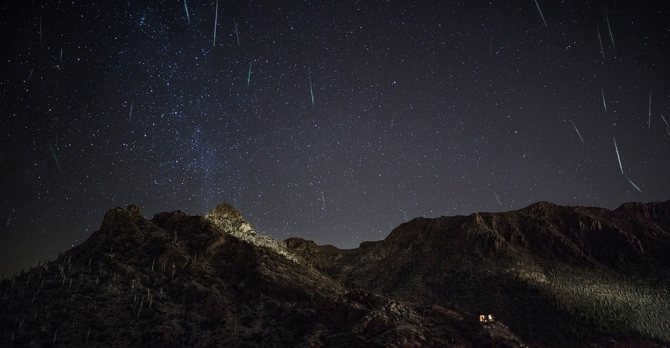
The Ursid meteor shower, also known as the “starfall,” is not well-studied and takes place between December 17 and 25. The Little Dipper serves as the radiant, located near the Little Ladle. On average, during the most active days, observers can see 10 to 20 meteors per hour, which may not be very exciting for the average viewer. However, there are occasional unpredictable bursts of activity where the number of meteors exceeds a hundred. These meteor showers had particularly high activity in 1988, 1994, 2000, 2006, and notably in 1945 and 1986. The Ursid meteor shower is the most northern of its kind and is believed to originate from the short-period comet Tuttle.
Fact #8. Polaris has dimmed over time.
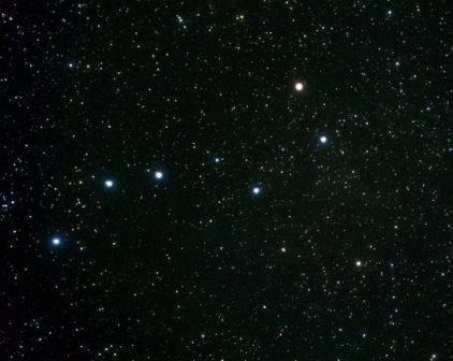
The Greenlandic storytellers’ interpretation of how the constellation came to be
Eriulok, filled with despair, ventured to the Arctic Ocean and summoned the divine Arnarkuachssak, the ruler of the ocean’s depths. He shared his woes with her, and in response, the goddess vowed to assist him. However, there was a condition – Eriulok had to retrieve a ladle filled with magical berries that would restore the goddess’ youth. Accepting the challenge, the hunter embarked on a journey to a remote island, where he discovered a cave guarded by a formidable bear. After enduring great hardship, he managed to lull the beast to sleep and pilfer the ladle adorned with the precious berries. True to her word, the goddess rewarded the hunter by bestowing upon him a wife and granting him the magic berries. With all his trials behind him, Eriulok married and became the proud father of a large family, envied by all his neighbors. As for the goddess, she consumed all the berries, regaining her youth by several centuries and exuberantly tossed the empty ladle into the sky, where it became entangled on an unknown object and remained suspended.
The coordinates it possesses

Currently, the brightness of Polaris, the brightest star in the constellation Ursa Minor, is moderate with an apparent magnitude of 1.97 (which can vary). Its declination is +89°19’8″ (during the J2000 era it was +89°15’51.2″), which means it always points north within a degree. In fact, Polaris remains fixed in the sky, always in the same place. However, it is not visible at the equator, unless we consider atmospheric diffraction, but it cannot be considered a complete observation.
Did you know? The distance to Polaris is a fascinating fact!
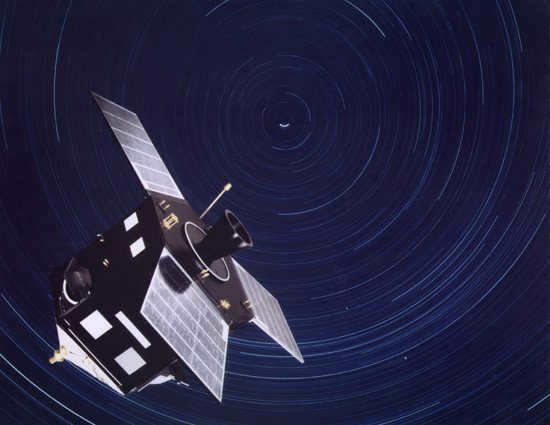
0
As mentioned earlier, Cepheids play a crucial role in the field of astronomy. Their pulsation periods are directly related to their luminosity, making them valuable tools for measuring the distances to other galaxies. One of the closest Cepheids to Earth is Polaris, which is estimated to be about 400 light-years away. However, determining the exact distance to Polaris is challenging due to the large error in parallax measurements at this distance. The most accurate parallax measurement of Polaris, obtained by the HIPPARCOS satellite, has an error of approximately 8 light-years or about 2%.
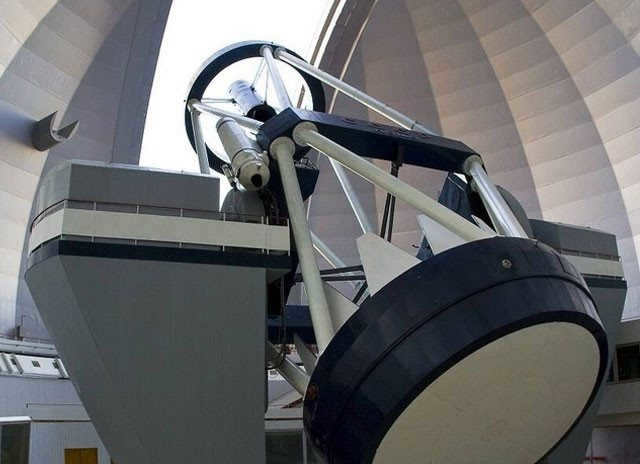
0
A recent article by astronomer David Turner revealed that the current estimate of the distance to Polaris is actually 111 light years less than what was measured by the Hipparcos satellite. Turner conducted his research using the BTA telescope, the largest telescope in Russia with a mirror diameter of 6 meters. In response, Dutch astronomer Floor van Leeuwen, who is responsible for the Hipparcos data, wrote a counter article defending the accuracy of the satellite’s measurements and contradicting Turner’s findings. This debate quickly spread across the internet and gained attention from various media outlets. The implications of accepting the new distance to Polaris are significant, as it would suggest that the true scale of the Universe has been greatly overestimated. This could call into question the current understanding of the rate of expansion of the Universe, a topic that has already been awarded the Nobel Prize in 2011. The question remains: who is right…
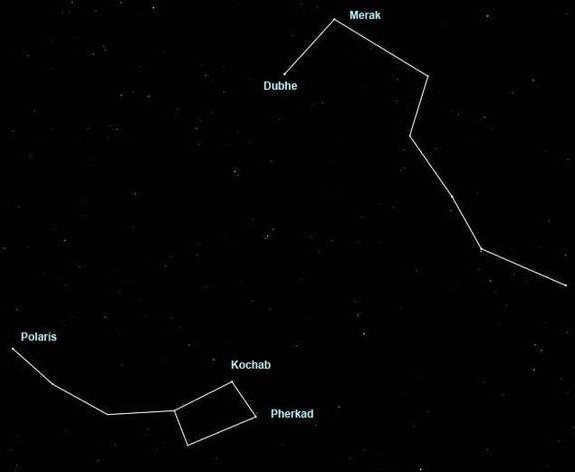
There is a poignant legend that revolves around the constellation of the Great Dipper and the Small Dipper. In a time long, long ago, amidst the hills and valleys, stood an ordinary village. Within this settlement dwelled a sizable family, and within it blossomed a daughter named Aina. No one in the vicinity was kinder than this young girl. One fine morning, a somber carriage appeared on the road that led to the village. It was drawn by ebony horses. Perched upon the carriage was a man, clad in dark attire. He wore a broad smile, exuding cheerfulness and occasional laughter. Resting upon the carriage was a shadowy cage, within which a young polar bear cub was shackled. Great tears streamed from the creature’s eyes. Many villagers were incensed: was it not a disgrace for such a towering, dark figure to keep a tiny polar bear cub enchained, subjecting it to torment and cruelty? The villagers seethed with indignation, but no further action was taken.
It was not until the cart arrived at the house where Aina resided that the compassionate girl halted its progress. Aina implored the stranger to release the bear cub. The stranger chuckled and proposed that he would set the cub free if someone would offer up their own eyes. None of the villagers entertained the idea, except for Aina. The dark-skinned man agreed to release the bear cub in exchange for the girl’s sight. And so Aina was robbed of her vision. The polar bear cub emerged from its confinement, and its eyes ceased to weep. The cart, along with the horses and the dark-skinned man, vanished into thin air, while the polar bear cub remained in its place. Approaching Aina, who wept bitterly, the bear cub presented her with a rope fastened to its collar and guided her through the fields and meadows. The onlookers witnessed the polar bear cub transforming into the constellation known as the Big Dipper, and Aina transformed into a small polar bear cub. Together, they ascended into the heavens. Since that moment, they have been seen traversing the sky side by side. They eternally reside in the celestial realm, serving as a reminder to humanity of both good and evil. Such is the moral tale that the constellations of the Big Dipper and the Little Dipper are renowned for.
Popular topics for posts
- Folk Dancing
Folk dancing is among the oldest forms of art. Throughout history, individuals have subconsciously sought to express their feelings and emotions through bodily movements. - Caucasus Mountains
The Caucasus Mountains are renowned for their stunning beauty, formed as a result of the collision between the Arabian and Eurasian plates. They serve as a symbol of the unique culture, people, and mindset that have developed over time. - Veterinarian profession
The profession of a veterinarian has a long and storied history. As soon as humans began domesticating animals, there arose a need for individuals to care for, tend to, and treat them.
For a significant period, there was a lack of consensus on the official designation
The formation of stars known as the Little Bear resembles a dipper, much like the well-known Big Dipper. The Phoenicians, renowned navigators of ancient times, utilized this grouping of celestial bodies for their navigational needs. However, Greek sailors relied more on the Big Dipper for orientation. The Arabs perceived the Little Dipper as a rider, while the Indians associated it with a monkey that clings to the center of the world with its tail and revolves around it. Clearly, there was a prolonged absence of a universally accepted interpretation and name, with each civilization attributing their own unique and easily comprehensible meaning to the starry expanse. What other insights can the Big Dipper constellation provide?
Fact #1. Polaris is not the most luminous star in the celestial sphere.
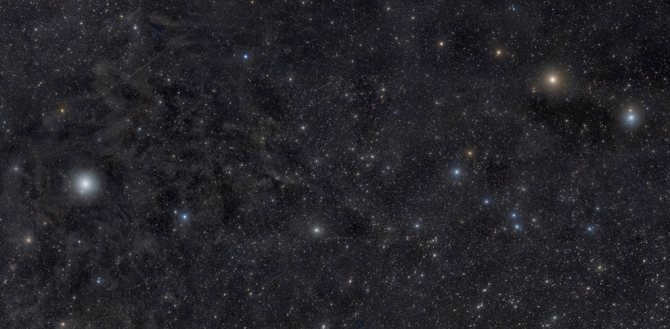
0
The misconception that Polaris is the most luminous star is widely believed. Many individuals who lack familiarity with the celestial sphere presume that Polaris emits a high degree of brightness, if not the highest among all stars. However, this is not the case. Polaris ranks a mere 46th on the list of the most brilliant stars in the firmament, trailing behind luminaries such as Sirius, Vega, and Arcturus.

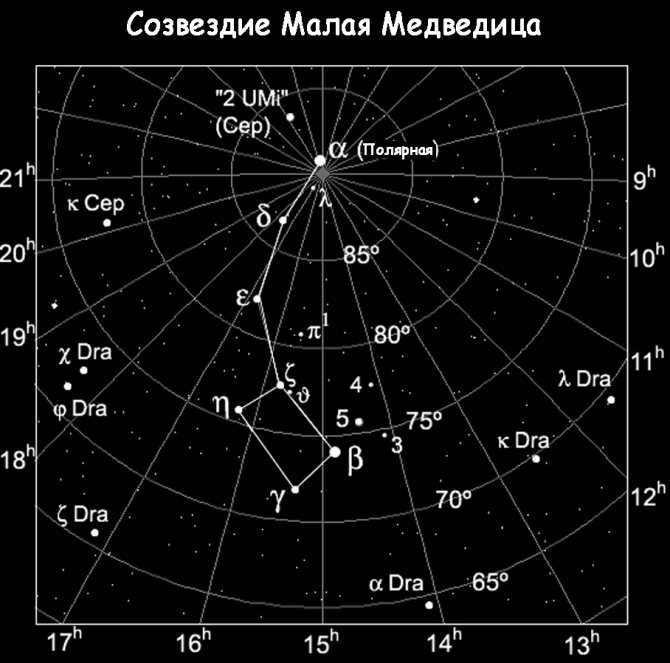
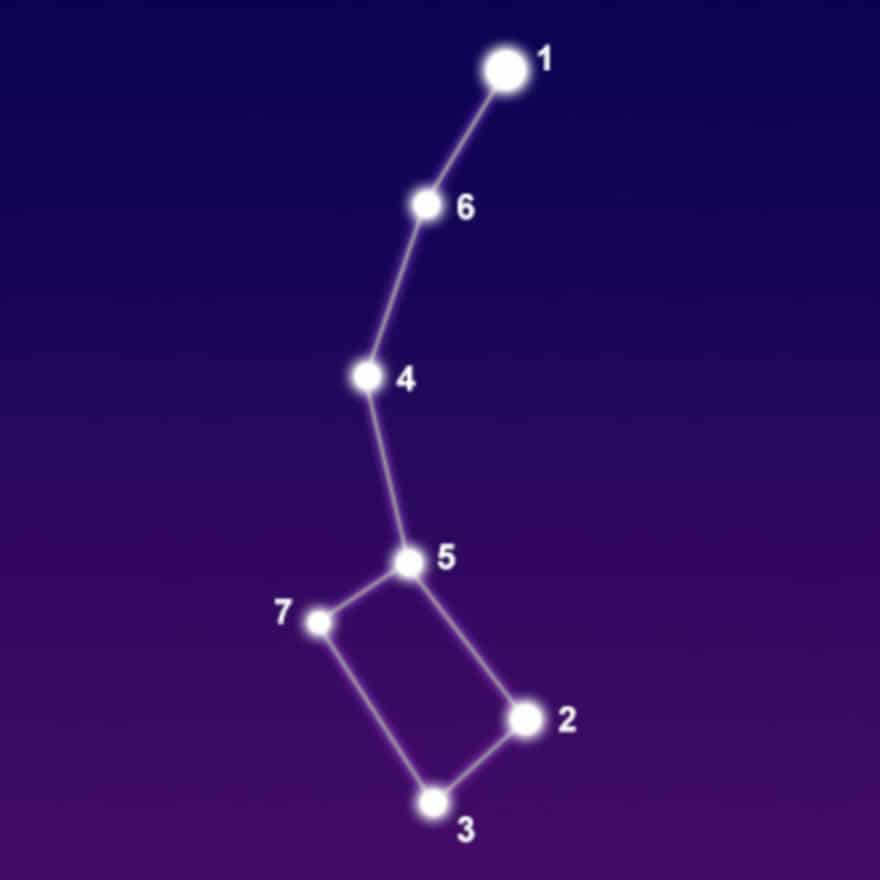

Undoubtedly, the Little Bear is the most renowned constellation in the northern hemisphere’s celestial sky. It is the subject of countless inquiries from children who often attempt to spot it in the night sky.
What makes it so captivating, considering the unassuming appearance of the Little Dipper? Primarily, it houses Polaris, a star of immense importance in land navigation. It is crucial for everyone to possess the skill of locating Polaris, as it can prove to be life-saving knowledge. Therefore, it is highly recommended to introduce your children to this constellation and Polaris. This knowledge can be invaluable and may even save lives.
Now, let’s delve deeper into the Little Bear from the perspective of an avid astronomer.
The Small Bear in the Firmament
The Small Bear is situated in the celestial region encircling the Earth and can be seen throughout the year in the northern hemisphere. It is identified as Ursa Minor, or UMi. Its stars are arranged in a manner that resembles a “container” similar to the Big Dipper, albeit with a handle that is curved differently.
In the heavens, the Small Bear is positioned in the northern direction. The final star in its tail is Polaris, which remains fixed in its position. Its elevation above the horizon is equivalent to the latitude of the observation site, thereby serving not only as a guide to the north, but also enabling precise determination of one of its coordinates. This characteristic was recognized and utilized by the Phoenicians, granting them a significant advantage at sea for over a millennium.
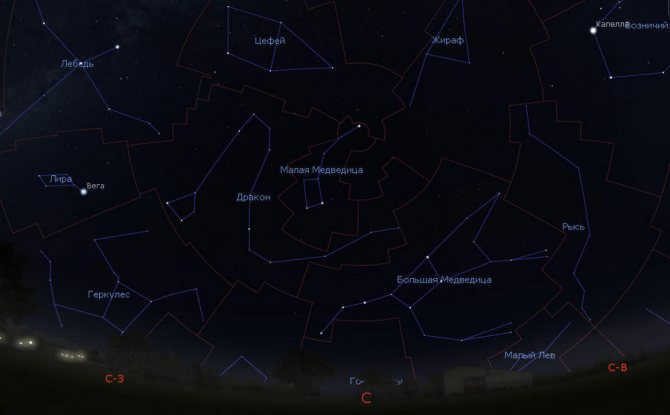
The constellation of Ursa Minor, also known as the Little Bear, can be observed in the northern hemisphere throughout the year. Its position on January 1st remains fixed, while the rest of the constellation may appear to rotate counterclockwise around Polaris, the North Star.
Interestingly, in Russia, Ursa Minor can be seen on any clear night as it never sets below the horizon. This makes it a reliable and easily recognizable constellation for stargazing enthusiasts.
Located near Ursa Minor is the Big Dipper, a larger and more prominent constellation. By drawing a line through the two outermost stars of its “bucket”, one can navigate towards Polaris. This method is commonly used to introduce children to the night sky.
Ursa Minor is relatively small compared to other constellations, ranking 56th in terms of size. It covers an area of only 256 square degrees in the sky.
Asterisms
An asterism is a group of stars that form a recognizable pattern within a larger constellation. They are often used as visual aids in locating specific celestial objects or for navigation purposes. These patterns are not officially recognized as constellations, but they are well-known among amateur astronomers and stargazers. Some famous asterisms include the Big Dipper, Orion’s Belt, and the Summer Triangle. While they may not have the same scientific significance as constellations, asterisms add beauty and intrigue to our night sky.
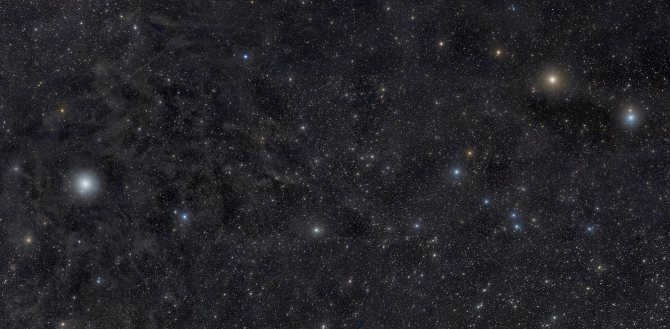
Photo taken by astrophotographer Rogelio Bernal Andreo captures the Small Bucket Asterism.
Within this constellation, there are two notable asterisms: the Small Bucket and the Guardians of the Pole. The former is familiar to modern observers and resembles the nearby Big Bucket, albeit with less brightness. It consists of the most prominent stars within the celestial formation. While many believe that the Little Dipper is comprised solely of these seven objects, there are actually 18 additional stars that contribute to its composition.
The second asterism, less well-known, traces its origins back to ancient times when its two constituent stars, Ferkad and Kohab, were positioned closer to the pole than Polaris.
Myth of the Little Bear constellation
There are numerous tales surrounding this particular constellation, each with its own unique twist. One of these stories revolves around the birth of Zeus, the supreme and most powerful god in ancient Greek mythology. Zeus’s father, Cronus, had a peculiar habit of devouring his offspring, as it was prophesied that one of his children would eventually overthrow him. When Zeus was born to his mother, the goddess Rhea, she decided to hide him away in a sacred cave atop Mount Ida. It was there that the nymphs Melissa and Kinosura took it upon themselves to raise and nurture the young god. Kinosura became Zeus’s caretaker and nurse. As Zeus grew into his divine powers, he elevated Melissa to the heavens in the form of the Big Dipper, while Kinosura ascended as the Little Dipper.
This legend has various versions. For instance, there is a variation that tells the story of Zeus being nurtured by the goat Amalthea and two actual bears, which later transformed into constellations.
There is another tale associated with the Ursa Minor constellation. In the land of Arcadia, King Lycaon ruled, and he had a stunning daughter named Callisto. Her beauty was so extraordinary that even the goddess Hera, Zeus’ wife, became envious. With her immense power, Hera transformed Callisto into a hideous bear.
One day, Callisto’s son Arkadus was hunting in the forest and almost killed a bear that he encountered – unaware that it was his own mother. Fortunately, Zeus intervened just in time and diverted the arrow. He then placed Callisto in the sky as the constellation Ursa Major, and her beloved dog as the constellation Ursa Minor. Arkadus himself became the constellation Volopassus, and its primary star Arcturus signifies “guardian of the Bear.”
By the way, Hera had a valid reason to be jealous – Arcade was the son of Zeus, who once couldn’t resist the beauty of Callisto and seduced her.
Every country has its own myth about the Great Bear and the Little Bear. The former is easily recognizable in the night sky, while the latter has the unique characteristic of revolving around Polaris. Interestingly, the Kazakhs regarded this star as a nail, with the constellation itself being a harness tied to it and worn around the neck of the Horse (the Great Bear). In India, the Little Bear was believed to be a monkey hanging onto its tail, which was hooked onto the axis of the world.
Adjust the positioning of the stars based on the time of day
Focus on how the constellations of the Big and Little Dipper shift as the day progresses. For instance, during the nighttime in February, we observe the bucket with the handle pointing downward, situated in the northeast. However, in the morning, the constellation will shift to the northwest, with the handle pointing upward.
Interestingly, the five stars within the bucket form a distinct group and move independently from the other two stars. Dubhe and Benetnash are slowly drifting apart in the opposite direction from the other five stars. Consequently, in the foreseeable future, the ladle will assume an entirely different appearance. However, we will not have the opportunity to witness this transformation, as a significant change will only become noticeable in approximately one hundred thousand years.
The members of the Little Dipper constellation
The group of stars known as the Little Dipper is composed of seven celestial bodies:
- α – Polaris.
- δ – Yildun
- ε – Urodelus.
- ζ – Alifa al Farqadin.
- η – Anwar or Allaso
- β – Kohab
- γ – Ferkad
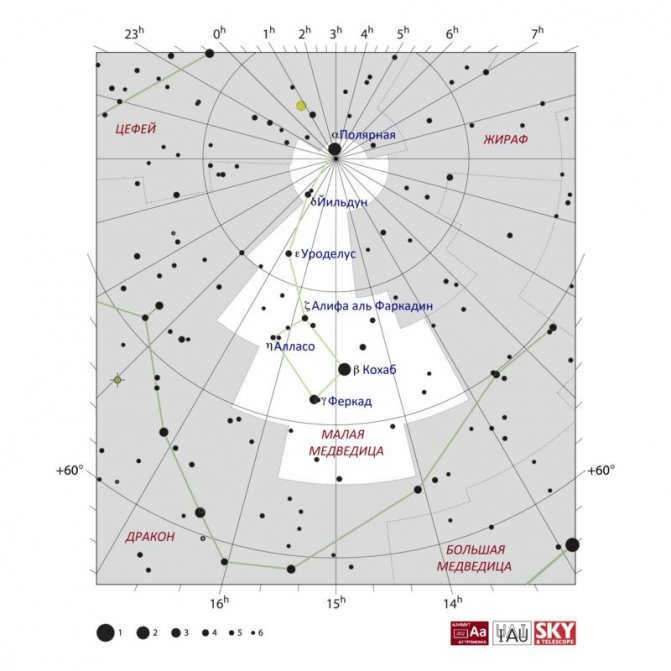
Illustration showcasing the arrangement of stars in the Little Bear constellation. Reference: Wikipedia.
The two farthest stars, Cohab and Ferkad, are commonly referred to as the “Pole Guardians”. Certain stars within this constellation possess intriguing characteristics, hence we shall examine each of them in a systematic manner.
When observed from the sky, Polaris appears as an ordinary little star with a magnitude of 1.97. There are numerous stars of similar brightness in the vicinity, and if it weren’t for its close proximity to the pole, it would likely go unnoticed. However, upon closer examination, Polaris has some intriguing qualities.
Polaris is located at an impressive distance of approximately 447 light years, making it a destination that would take an exceedingly long time to reach. Nevertheless, if we were able to travel to Polaris, we would discover that it is actually a triple star system!
Even from Earth, we can discern the binary nature of Polaris through a telescope. At the heart of the entire Polaris system resides a supergiant star that is approximately 50 times larger than our Sun, 6.5 times more massive, and radiates light 2000 times more brightly.
An ordinary star is located 2400 astronomical units away from this monstrous object. It has a mass that is only 1.39 times greater than that of the Sun, and it is visible from Earth, even with a small telescope, as a star with a magnitude of 9m. This star takes 100,000 years to complete a full orbit.
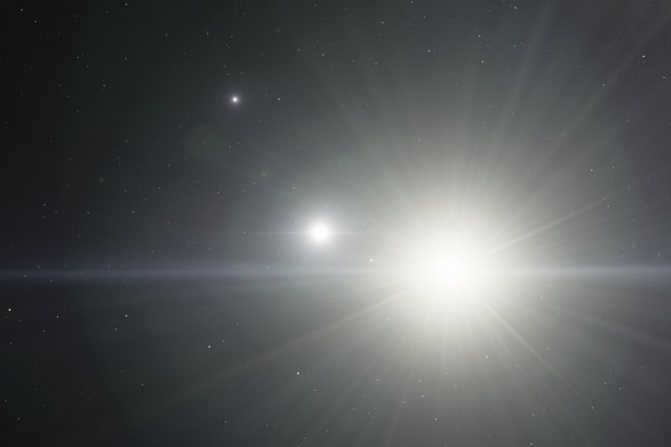
William Herschel discovered this particular star in 1779. Despite its yellowish white appearance, when observed through a telescope, it appears greenish due to an optical illusion. Therefore, I encourage you to take a closer look at this stellar pair as it possesses a captivating beauty.
The third component of this celestial system is in close proximity to the central supergiant. With a mass 1.26 times that of the Sun, this star completes a full revolution in a span of 30 years. It is officially designated as Polaris B.
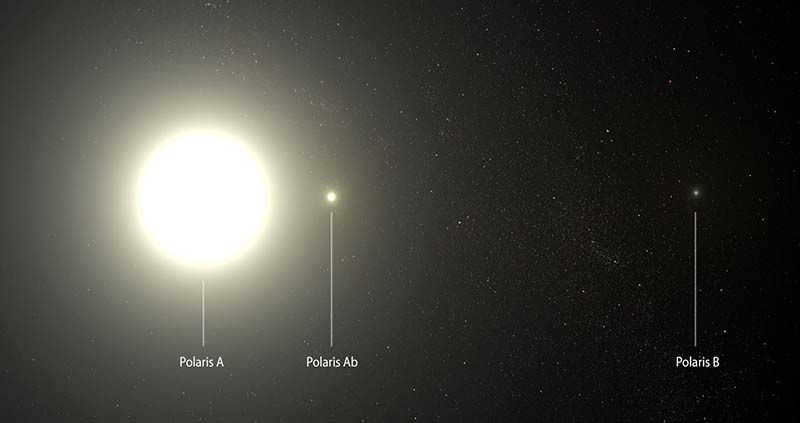
However, Polaris possesses another characteristic – it is a variable star of the Cepheus delta classification, specifically a Cepheid star. Furthermore, it is the nearest Cepheid star to our location among all those currently identified. To clarify, Cepheids are stars that pulsate in a strictly periodic manner, causing their luminosity to fluctuate. Nevertheless, Polaris stands out as an atypical Cepheid due to its subdued pulsations. In fact, its luminosity used to vary significantly more a century ago compared to its present levels, with a noticeable increase in brightness.
Polaris is famous for its proximity to the North Pole. However, it hasn’t always been the polar star and it won’t always be in the future. Due to the Earth’s axis precession, different stars will take its place as the polar star. Therefore, in 2102, Polaris will be the closest to the North Pole, but then it will gradually move away. Starting from 3200, the gamma star of Cepheus will be the closest to the pole, and in 13000 years, it will be Vega, the alpha star of Lyra. Interestingly, Vega was already the polar star 13000 years ago, during our ancient era.
Yildun: the Delta of the Little Bear
Yildun, also known as Delta Ursae Minoris, is a relatively young star with an estimated age of approximately 170 million years. It possesses a high surface temperature of 9900 K, classifying it as a white dwarf star. Despite its hot nature, Yildun has a larger radius than our Sun, measuring 2.8 times its size. This star is located at a distance of 172 light years from Earth, making it closer to us than the famous Polaris.
Due to its rapid rotation, Yildun is expected to exhibit noticeable flattening at its poles. In approximately 700 million years, this star will undergo a transformation into a red giant, a fate that awaits our Sun in the distant future. As Yildun approaches us, it will gradually become brighter, illuminating the night sky with its presence.
Urodelus: The Epsilon Star of the Little Dipper
Urodelus is a unique star within the Little Dipper constellation. What makes it truly fascinating is that it is actually a double star system. The primary star at the center is an orange giant, boasting a size 19 times larger than our Sun and a weight three times heavier. Despite its immense size, its temperature remains almost the same as the Sun due to its significantly larger surface area. As a result, it emits a staggering 225 times more light than our Sun.
The second star in the Urodelus system is not as extensively studied as its counterpart. However, researchers have discovered that it is a white main-sequence star. The most intriguing aspect is its orbit, which completes in just 39.5 days. This close proximity between the stars leads to periodic eclipses, with the smaller star occasionally obscuring the larger one. Consequently, the brightness of the Urodelus system fluctuates, leading to its classification as an Algol-type variable star.
Located approximately 300 light-years away, the Urodelus double star system continues to captivate astronomers. Furthermore, its distance from us is rapidly diminishing, with Urodelus moving closer by 10.5 km every second.
Alifa is a hot white star of no particular note, with a surface temperature of approximately 9000 K. It is six times larger than the Sun and emits 191 times more light than our star. Alifa is located at a distance of 337 light years from Earth, giving it the appearance of a faint star with a brightness of only 4.2m in our sky.
Is Allaso one of the stars in Ursa Minor?
Allaso, also known as Anwar al Farkadin, is another star with a popular name. In the night sky, it appears as an unremarkable star with a brightness of 4.95m. Allaso is situated 96 light years away from our planet.
Upon closer observation, it becomes apparent that Allaso is actually a binary star system. The primary star in this system is a white-yellow dwarf, which is nearly twice the size of the Sun, 1.66 times more massive, and slightly hotter. This is what we perceive when looking at the sky.
The second element is not well understood. It is recognized as a crimson dwarf located 13 light-years away from the main star. Although this is a considerable distance, gravitational interaction remains feasible.
Cohab represents the beta star in the constellation Ursa Minor.
Within this constellation, the second brightest celestial body is an orange giant, surpassing the Sun in size by 42 times and in mass by 2.5 times. Kohab emits a stunning 400 times more light than our Sun – if it were positioned at the center of our solar system, its colossal radiation would scorch everything in its path.
Kohab is accompanied by a yellow-orange satellite with an intensity rating of 11.3, which can be observed at an angular distance of 3.4 seconds.
In 2014, astronomers discovered a massive exoplanet in Kohab that is 6 times more massive than Jupiter. This planet, with a maximum distance from its star of only 1.4 astronomical units (a.u.), completes a full orbit in 522 days. Due to its size and the power of its star, this exoplanet can be classified as a hot Jupiter.
Moving on to another celestial object, Ferkad is the gamma star of the Little Dipper. Ferkad is an ordinary white giant that is 15 times larger than the Sun and 8 times heavier. It emits 1100 times more light than the Sun, giving it a brightness of about +3m in the sky, despite being located approximately 480 light years away from us.
Ferkad is classified as a variable star of the Delta Shield type. It undergoes changes in brightness, with fluctuations of 0.05m occurring every 3.43 hours. These fluctuations are caused by ripples on the surface of the star.
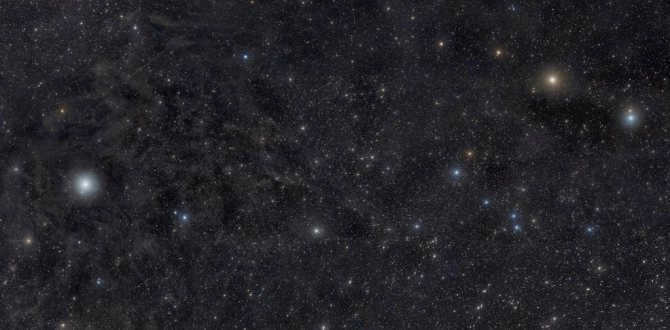
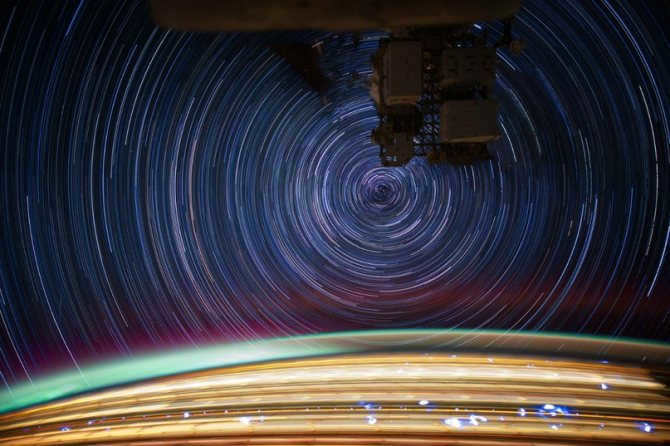
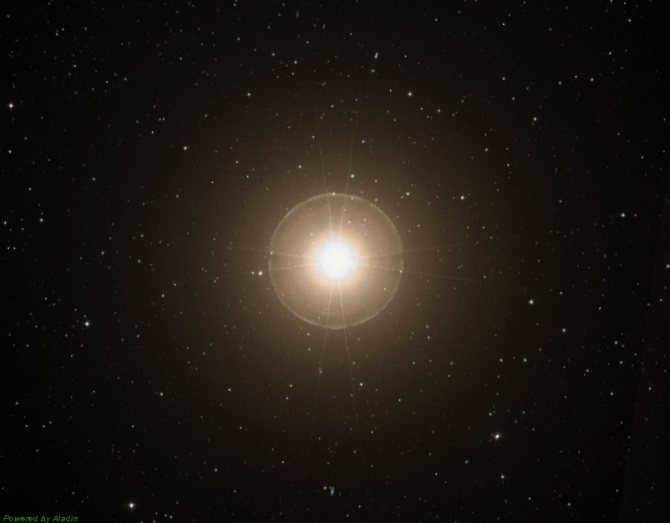
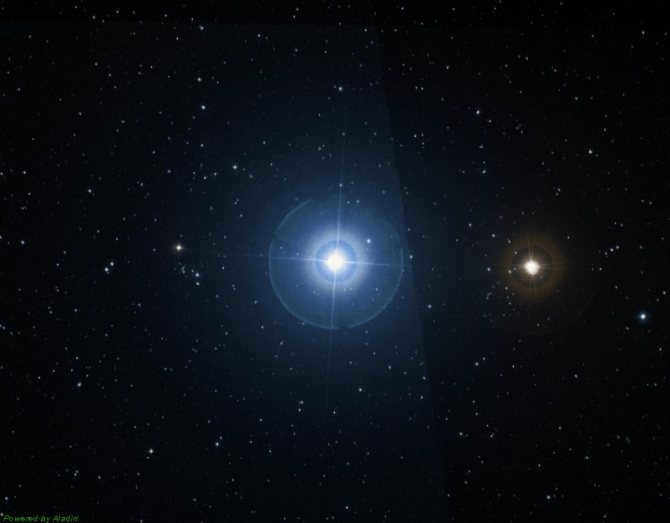
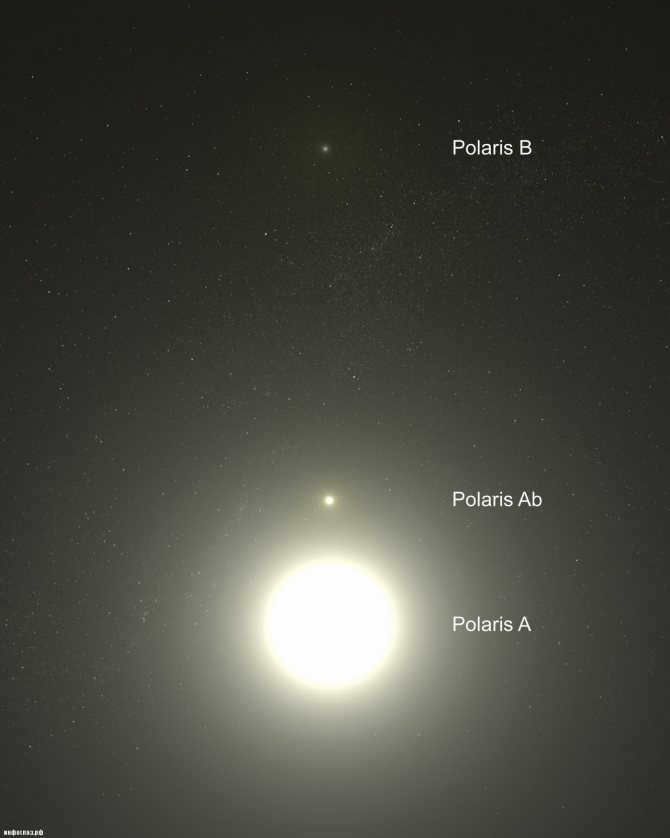
Polaris has caught the attention of scientists for various reasons. Not only is it a triple system, but it also has unique characteristics. Polar A, for instance, is a supergiant star that shines two thousand times brighter than the Sun. Its closest companion, Polaris Ab, is located just eighteen and a half astronomical units away from the supergiant. Despite its proximity, it remained unnoticed for a significant period of time. On the other hand, Polaris B is the third companion, positioned at a considerable distance from the double system and completing one revolution around it every thirty years.
Furthermore, Polaris, specifically its main component, falls into the category of Cepheids, which are variable stars that undergo changes in size and luminosity within specific time intervals. The period for Alpha of the Little Bear is 3.97 days. What sets this cepheid apart is the fading of its pulsations and a subsequent increase in brightness, which amounted to a fifteen percent gain.
Galaxies in the Ursa Minor Constellation
When it comes to amateur stargazing, the Ursa Minor constellation doesn’t offer much in terms of visible objects. However, there is a solitary galaxy that can be observed – a diminutive elliptical galaxy affectionately known as the Little Dipper.
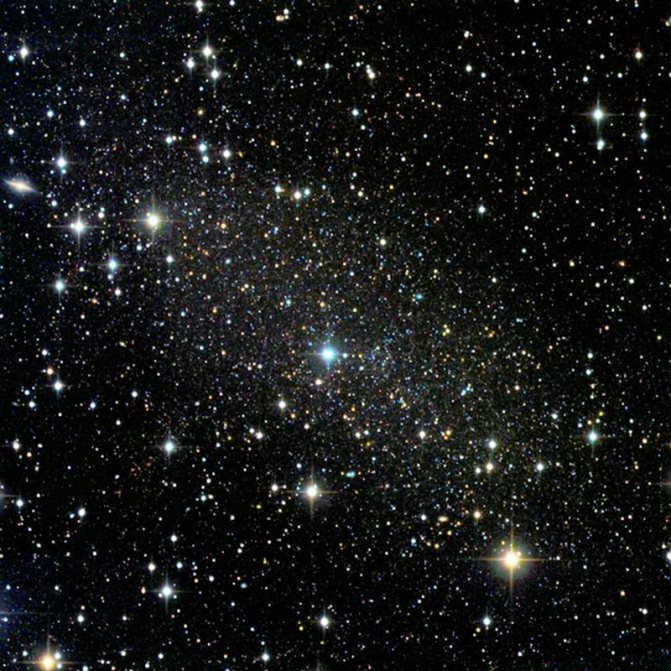
The galaxy known as the Little Dipper is home to a group of aging stars. It is believed that star formation in this galaxy occurred approximately 14 billion years ago and lasted for a period of 2 billion years. Since then, the emergence of new stars in this galaxy has been relatively rare.
Similar to the Magellanic Clouds, the Little Bear Galaxy exists as a satellite of our own Milky Way.
Fascinating items
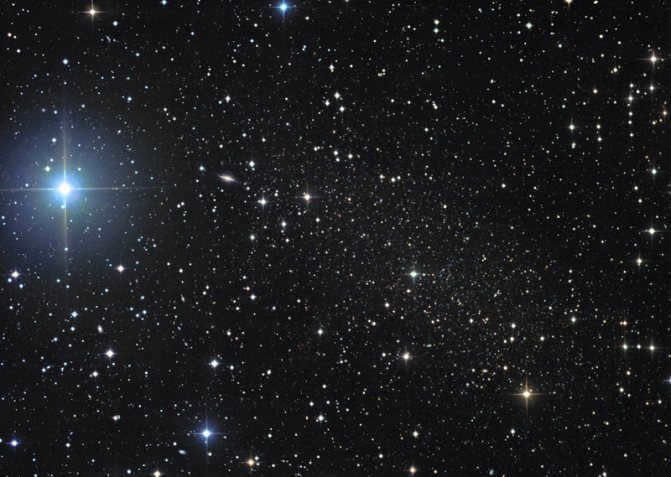
Photo The Little Dwarf Galaxy of the Little Bear
In addition to the primary stars, there is a fascination with the galaxies situated in the constellation Ursa Minor. The aforementioned Dwarf galaxy, which accompanies the Milky Way, was detected in 1954. This galaxy is quite ancient, with an age of at least ten billion years. It is too diminutive to discern whether it possesses gas, dust, or any stellar formation activities. It is occasionally referred to as Polarissima due to its proximity to the Earth’s axis of rotation.
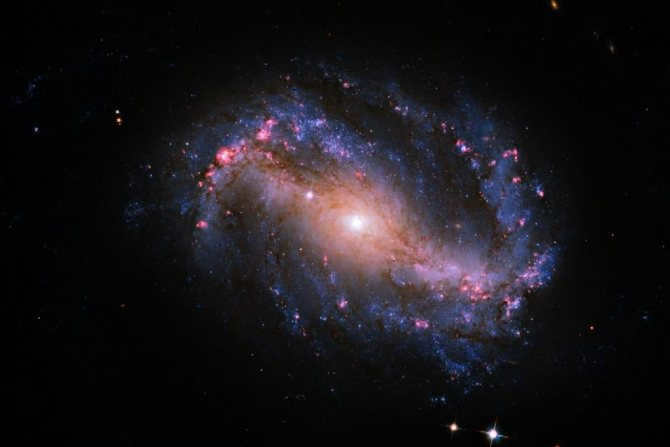
Furthermore, the constellation is home to the galaxies NGC 6217 and NGC 5832. These celestial objects are relatively minuscule in the grand scheme of the universe, making them difficult to observe without the aid of quality optical instruments.
Meteor showers in Ursa Minor
Ursa Minor is host to a single meteor shower known as the Ursids. This celestial event commences on December 17th and typically lasts for approximately one week. The peak of the shower occurs on December 22nd, during which observers can expect to see around 10 shooting stars per hour. However, there have been instances where the Ursids displayed a remarkable surge in activity, such as in the year 1945 when it produced an astonishing 120 meteors per hour.
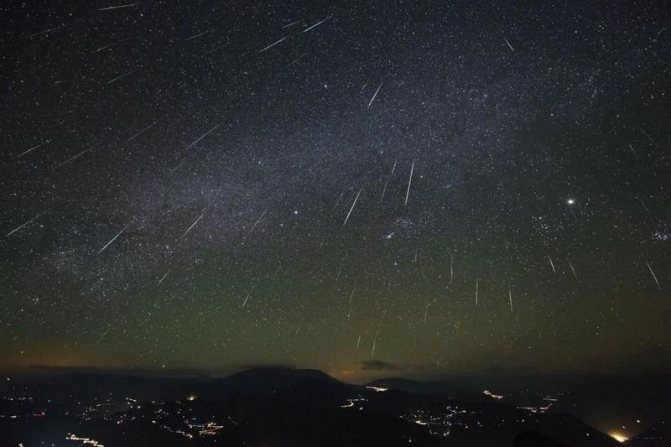
The Ursids meteor shower is caused by the comet Tuttle, which was initially detected in 1790 by Pierre Mechene. This comet completes one full orbit around the sun in approximately 14 years.
The Ursa Minor constellation is perpetually visible in the night sky. Despite having only a few notable features, it’s worthwhile to locate and observe its stars. Don’t forget to point out Polaris to your children!

Planetary Systems
The constellation known as the Little Dipper contains numerous stars that have been observed to possess exoplanets. Among these stars is the well-known Kohab, as well as several other fainter stars. One of the planets in the Little Bear constellation is located approximately 390 light-years away from Earth. This planet is classified as an orange giant and is currently in one of the final stages of its life cycle. It has a radius equivalent to 24 times that of our own sun, but its mass is only 1.8 times that of our sun. In 2009, astronomers discovered a planet orbiting this star with a period of approximately 516 days. The mass of this planet is estimated to be around 10.5 times that of Jupiter.
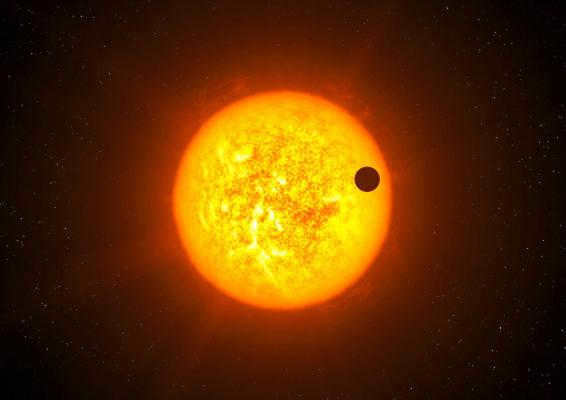
Astronomers have identified another star known as HD 150706, which is located 100 light-years away from Earth. According to scientific calculations, the star is orbited by a planet that completes one revolution around it in approximately six thousand days.
Mastering the art of spotting Perseus, Andromeda, and the Ascendant
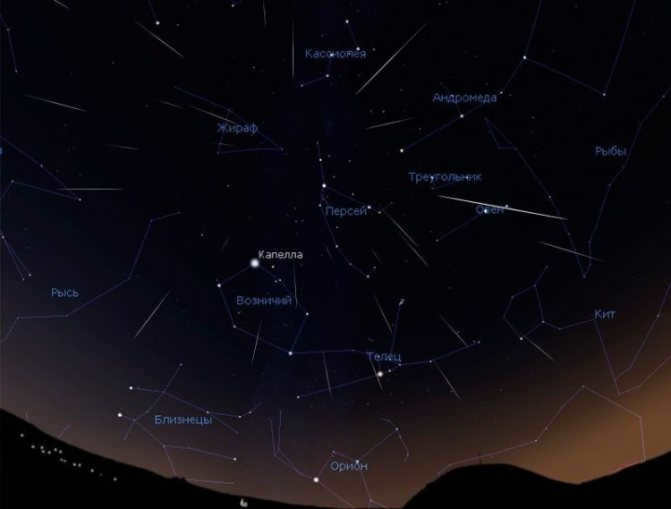
If you want to locate the Ascendant and the Pleiades, it is advisable to observe the night sky around midnight during the month of August, around 11 p.m. in September, and after 10 p.m. in October. To commence our celestial observation journey today, search for Polaris and then locate the constellation Cassiopeia. During these August evenings, it can be seen high in the northeastern part of the sky from the evening.
Extend your hand in front of you, spreading your thumb and forefinger as far apart as possible. This angle will be approximately 18°. Now, direct your index finger towards Cassiopeia, while pointing your thumb perpendicularly downwards. There, you will find the stars that belong to the constellation Perseus. Compare the observed stars with the fragment of the star map and commit to memory the position of the constellation Perseus.
When looking for Perseus, you might have observed a vibrant yellow star situated to the left and below Perseus. This particular star is known as Capella, the principal star of the Ascendant constellation. The Ascendant constellation itself can be seen beneath Perseus, but for a more optimal search, it is recommended to conduct observations after midnight. However, a portion of the constellation is visible in the evening (in the central region of Russia, Capella remains above the horizon throughout the night).
If you follow the path of stars in the Perseus constellation, as depicted on the map, you will observe that the chain initially descends vertically (consisting of 4 stars) before taking a right turn (consisting of 3 stars). Continuing along this mental straight line to the right, you will come across a shimmering cloud that, upon closer inspection by someone with normal eyesight, will reveal itself to be a cluster of 6-7 stars resembling a miniature “dipper”. This is the Pleiades diffuse star cluster.
The night sky during our early years never fails to astonish us, appearing impossibly vast and infinitely stunning. As we grow older, we begin to comprehend its expanse by identifying different regions. Typically, the first constellation children learn is the Big Dipper, while its enigmatic companion remains elusive for quite some time. Indeed, the Little Bear is not the most prominent constellation, and in urban areas saturated with artificial lighting, not all of its elements can be observed.
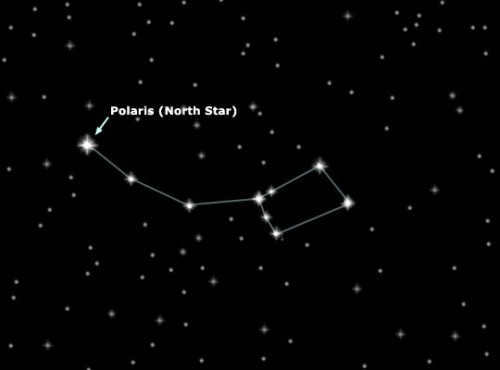
How to locate the Little Bear constellation?
Meanwhile, with the presence of the notable landmark known as the Big Dipper, it is rather simple to locate the constellation. The key is to distance oneself from the city lights, such as venturing into the depths of a park. To start, one must locate the Big Dipper asterism and its two outermost stars – Dubhe and Meraka. These stars must be connected by a line, which should be extended beyond Dubhe. Once the length of this imaginary straight line reaches five times the distance between Dubhe and Merak, the line will lead to Polaris, situated at the very end of the Little Bear’s tail. The other stars in the constellation form a downward arc away from Polaris and extend towards the Little Dipper asterism.
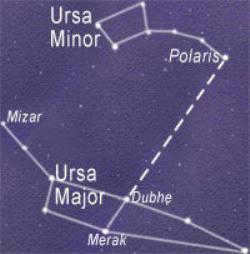
Brightness
The constellation known as the Little Dipper is not very prominent in the night sky. It consists of only a few stars that can be easily seen, even in areas with a lot of light pollution. These stars include Polaris (alpha), Cohab (beta), and Thercade (gamma). The remaining stars are either only visible with the help of binoculars or can only be seen when there is no artificial light present. Cohab and Ferkad can be found at the base of the Little Dipper.
Compact yet powerful
Despite its small size, the constellation known as the Little Dipper holds great significance in both scientific and fictional works. Covering a mere 256 square degrees, it ranks fifty-sixth out of the eighty-eight constellations. However, its age and depiction in ancient drawings, including Ptolemy’s “Almagest,” contribute to its continued popularity.
What sets the Little Bear apart? The answer lies in its prominent luminary, Polaris. For centuries, Polaris has captured the attention of observers, despite its dimness compared to other brilliant stars like Sirius or Vega. It is this star that has cemented the Little Bear’s reputation.
Geographical Position
The popularity of Polaris is largely due to its close proximity to the North Pole. Situated just one degree away from it in the constellation of the Little Bear, this star will even come half a degree closer by 2100, thanks to the precession of the Earth’s axis. It appears as though Polaris is suspended directly over the North Pole. In the past, explorers used its location to determine the cardinal directions, while its height above the horizon provided valuable information about their geographic latitude.
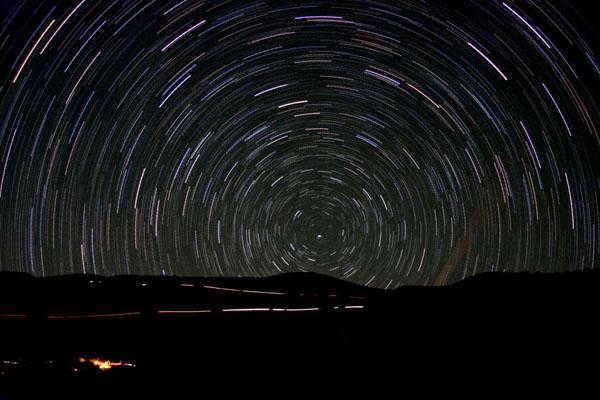
The North Pole is the point where the Earth’s axis extends, and it is the place where an imaginary line rests. From the surface of our planet, the stars that are located at this point seem to be motionless to an observer. Since around 1100, the star that all the others are revolving around is Polaris. However, after 3200, a new star will take its place in this position.
Unique Physical Traits
Scientists are particularly intrigued by Polaris due to its distinctive features. Notably, it is a trinary system. Polaris A is a massive supergiant star that outshines the Sun by a staggering two thousand times. Polaris Ab is its nearest companion, positioned just eighteen and a half astronomical units away from the supergiant. Despite its proximity, Polaris Ab remained undiscovered for a significant period. Meanwhile, Polaris B, the third companion, orbits the double system at a considerable distance and completes one revolution every thirty years.
Furthermore, Polaris, or more specifically the primary element of the system, is classified as a cepheid, which are variable stars that experience changes in size and brightness over a specific period. For the alpha of the Ursa Minor, this period is 3.97 days. The unique characteristic of this cepheid is the gradual decrease in pulsations, accompanied by a fifteen percent increase in luminosity.
The Keepers of the North Pole
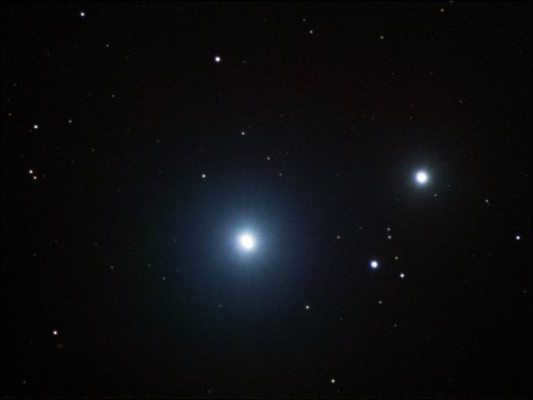
The constellation known as Ursa Minor contains several fascinating celestial objects in addition to Polaris. One notable feature is the asterism known as the Pole Guardians, which consists of two stars named Cohab and Ferkad. Cohab is a massive orange giant located 126 light-years away from Earth. It is the second-largest star in the entire constellation and held the position of the North Star from 2000 B.C. to 500 A.D.
Cohab also has a small companion star of the K5 class. In 2014, astronomers discovered a planet near this star guardian, estimated to be 6.1 times the mass of Jupiter.
Ferkad is a massive star that can be considered a sibling of Polaris, as it also falls into the category of Cepheids. With a pulsation period of 3.43 hours, Ferkad shines brightly in the night sky. Its name originates from Arabic, derived from the combination of gamma and beta of the Little Bear, known as “al-farkadan” in Arabic, which translates to “two calves”.
Planetary systems
The constellation known as Ursa Minor, or the Little Dipper, is home to a number of stars that have been found to have exoplanets. Among these stars is Kohab, as well as several other fainter stars. Located approximately 390 light-years away from Earth, the 11th planet in the Ursa Minor system is a large orange giant in the late stages of its evolution. With a radius 24 times that of our Sun and a mass only 1.8 times that of our Sun, this planet is unique. In 2009, a planet was discovered orbiting this star with a period of 516 days. This planet has an estimated mass of 10.5 times that of Jupiter.
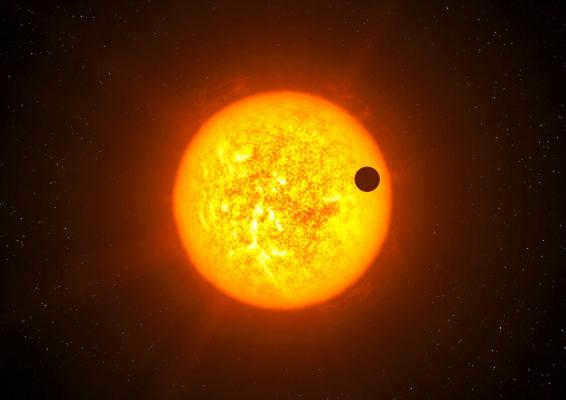
In the field of astronomy, HD 150706 is another star that is accompanied by a planet. It is located at a distance of 100 light years from Earth. Scientists estimate that this planet completes one orbit around its star in approximately six thousand days.
The eighth
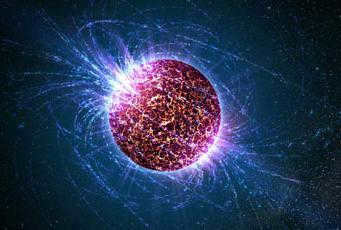
Furthermore, within the Little Bear constellation, an individual neutron star has been identified. This marks the eighth discovery of such a celestial object by scientists. This particular star exists in solitude, and there is no existing data regarding any explosive events that could explain its formation. The previous seven isolated neutron stars that have been discovered are collectively referred to as the “Magnificent Seven” in the scientific community. Therefore, the eighth neutron star has been named “Culver” in homage to the character from the film “The Magnificent Seven”.
To put it briefly, the Little Bear constellation, which you can see a photo of in this article, is more significant than it may appear at first. Its faint stars hold many intriguing secrets for the inquisitive mind. However, the presence of just one Polaris is sufficient to deem this small celestial pattern as one of the utmost importance in the realm of science.
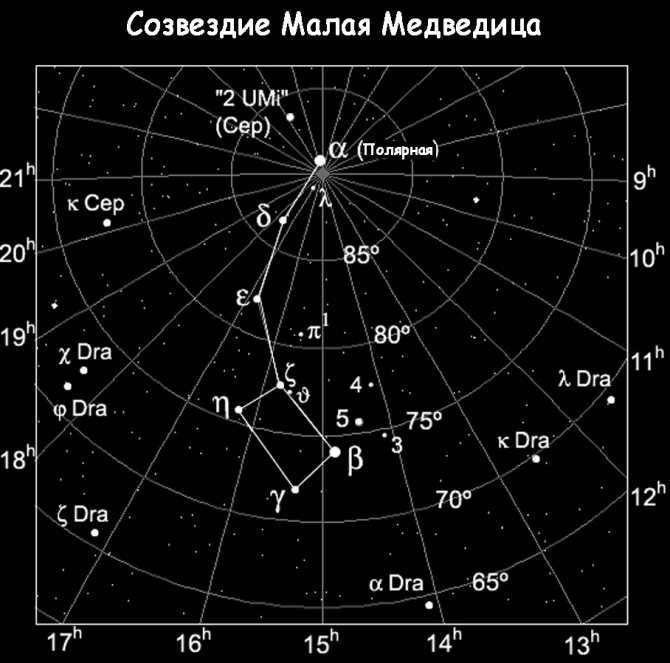
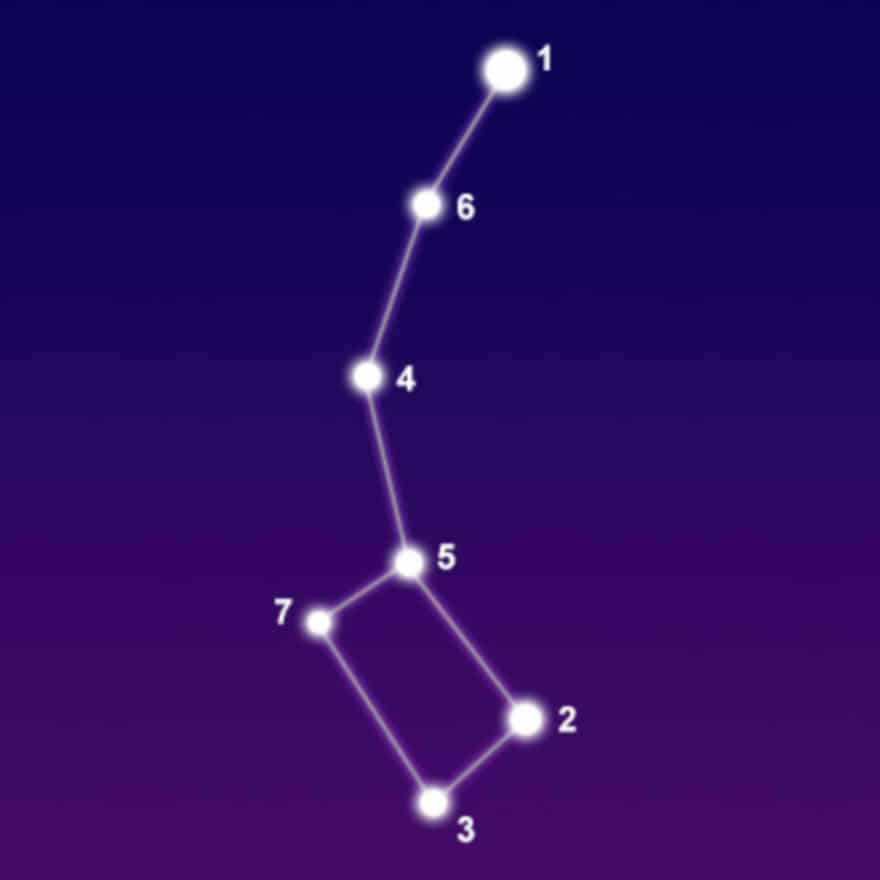
Arguably, there is no constellation in the night sky of the northern hemisphere more renowned than the constellation of the Little Bear. It is this constellation that children inquire about the most and even make attempts to spot it in the celestial dome.
What makes the Little Dipper so special and deserving of attention, despite its humble appearance? The primary reason is that it is home to Polaris, a star of significant importance in navigation and orientation. Knowing how to locate Polaris can be crucial in various outdoor activities, making it essential knowledge for everyone. Teaching your children about this constellation and Polaris could potentially save lives and is certainly valuable information.
Now, let’s delve deeper into the Little Bear constellation from the perspective of an astronomy enthusiast.
The Little Bear in the Celestial Sphere
The Little Bear, also known as Ursa Minor or UMi, is positioned in the circumpolar region and can be seen throughout the entire year in the northern hemisphere. Its configuration of stars resembles a “bucket” similar to the Big Dipper, but with a distinctively curved “handle”.
In the celestial sphere, the Little Bear resides in the northern direction. The final star in its tail is Polaris, which remains fixed in its position. The elevation of Polaris above the horizon, measured in degrees, corresponds to the latitude of the observation location. As a result, Polaris not only serves as a guide to the north, but also provides an accurate means of determining one of the coordinates. This characteristic was recognized and utilized by the Phoenicians, granting them a significant advantage in navigation for over a millennium.
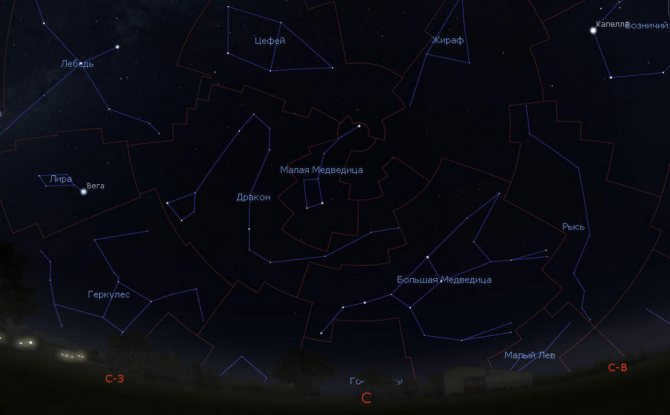
The Little Bear in the sky. Current position as of January 1st.
The position of the other stars in the Little Bear constellation may change throughout the year or day, appearing to rotate counterclockwise around Polaris. Interestingly, this constellation can be seen all year round in the northern hemisphere and is visible on clear nights in Russia, never disappearing below the horizon.
Adjacent to the Little Bear is a much larger and more prominent constellation known as the Big Dipper. By locating the Big Dipper and drawing a line through the two outermost stars in its “bucket”, you will be led directly to Polaris. This is a well-known and simple method to find Polaris and can be easily demonstrated to children as well.
In terms of size, the Little Bear constellation ranks 56th among all constellations and covers only 256 square degrees in the sky.
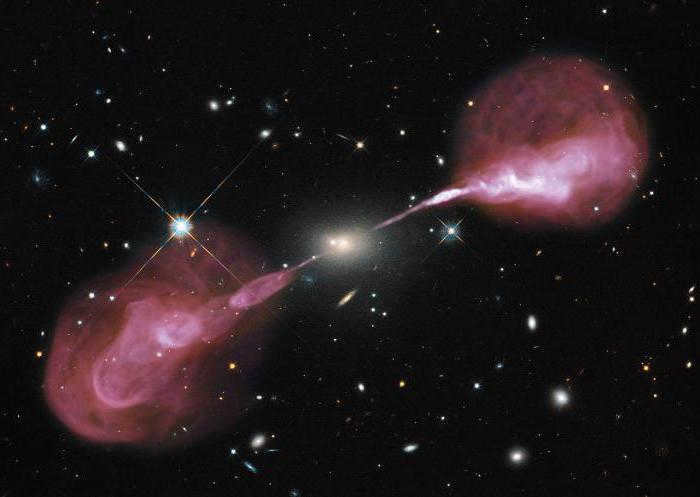
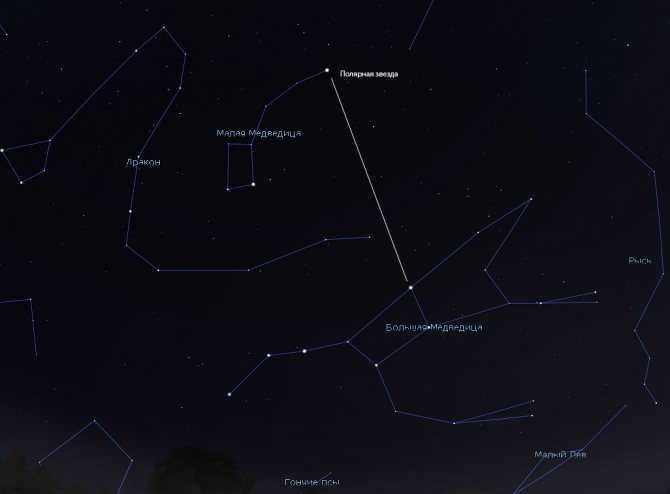
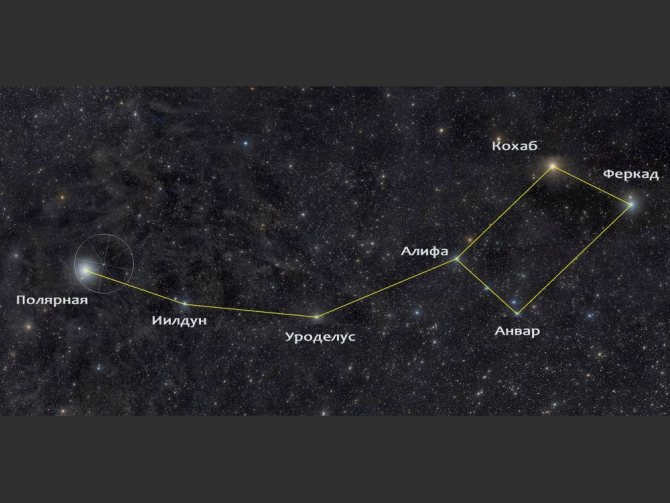
To ensure a successful experience of stargazing, keep in mind the following recommendations:
- Choose a clear night with no clouds or layered clouds in the sky to maximize your chances of seeing stars;
- Head out of the city, away from bright streetlights and illuminated windows, to a location with a vast dark sky where you can easily locate the Little Dipper;
- Position yourself in an area where tall trees or buildings won’t obstruct your view of the horizon. Ideally, find a spot with an unobstructed horizon.
Myth of the constellation of Ursa Minor
There are numerous myths surrounding the constellation of Ursa Minor, each with its own unique story. One of these myths revolves around the birth of Zeus, the supreme and fearsome god of ancient Greece. Zeus’ father was Cronus, a god known for his habit of devouring his own children, as it had been prophesied that one of them would overthrow him. When Zeus was born to his mother Rhea, she took him to a sacred cave atop Mount Ida. There, two nymphs named Melissa and Kinosura were entrusted with his care. Kinosura became Zeus’ nurse and played a crucial role in his upbringing. As Zeus grew into a powerful god, he immortalized Melissa by transforming her into the constellation known as the Big Dipper, while Kinosura was transformed into the constellation of Ursa Minor.
This legend also has various versions. For instance, one version states that Zeus was nurtured by the goat Amalthea and two actual bears, which later turned into constellations.
There is another tale related to the Ursa Minor. In the land of Arcadia, King Lycaon ruled, and he had a stunning daughter named Callisto. Her beauty was so unparalleled that even Hera, Zeus’ wife and goddess, became envious. Using her immense power, Hera transformed Callisto into a hideous bear.
One day, Callisto’s son Arkadus was hunting in the forest and nearly killed a bear that crossed his path – it turned out to be his own mother. Fortunately, Zeus intervened just in time and veered the arrow away. He then placed Callisto in the sky as the constellation Ursa Major and her beloved dog as the constellation Ursa Minor. Arkadus himself became the constellation Volopassus – its principal star, Arcturus, signifies “guardian of the Bear”.
By the way, Hera had a valid reason to be jealous – Arcade was the offspring of Zeus, who once refused to let the stunning Callisto slip away and instead seduced her.
Each culture has its own myth surrounding the Great Bear and the Little Bear. The former is highly conspicuous in the night sky, while the latter possesses the fascinating characteristic of orbiting around Polaris. Interestingly, the Kazakh people consider this star to be a nail, with the constellation resembling a harness fastened to it, worn around the neck of the Horse (representing the Big Bear). In India, the Little Bear is depicted as a monkey hanging from its tail, connected to the axis of the world.
The Origin of the Constellation
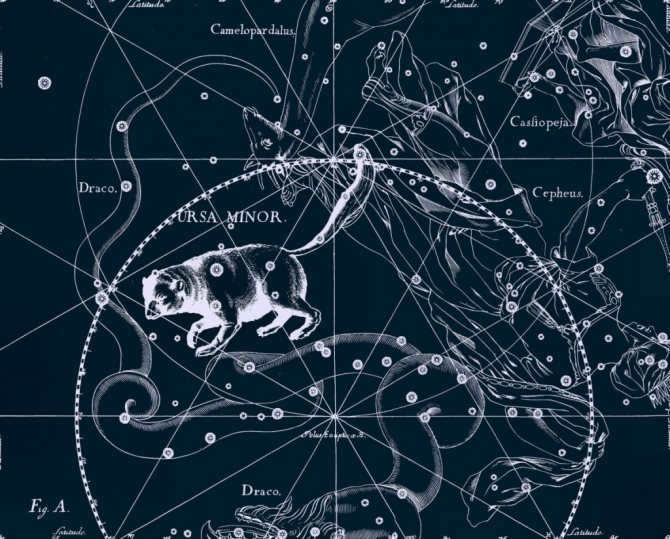
The Little Dipper, illustrated by Jan Hevelius in his atlas of constellations, is believed to have its origins in ancient times. According to ancient astronomers, it was introduced to the Ptolemaic catalog by Thales of Miletus. The Greeks often associated mythological events with the stars, and one interpretation suggests that this constellation represents the nymph Callisto, who was transformed into a bear along with her mistress. To protect them from harm, Zeus placed them in the sky, where they would live eternally. Many ancient civilizations were familiar with the stars in this constellation and used them for navigation purposes.
The Constellation of Ursa Minor
The asterism of the Ursa Minor constellation is comprised of seven stars:
- α – Polaris.
- δ – Yildun
- ε – Urodelus.
- ζ – Alifa al Farqadin.
- η – Anwar or Allaso
- β – Kohab
- γ – Ferkad
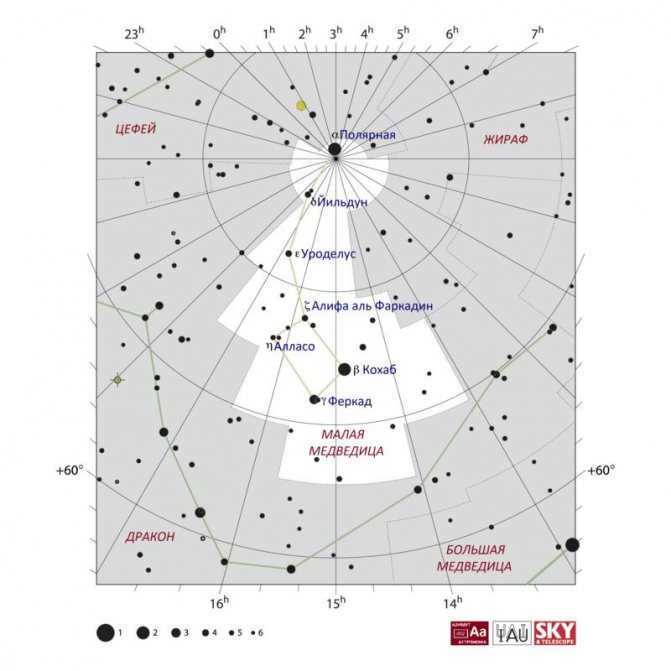
Illustration showcasing the arrangement of stars within the constellation known as the Little Bear. Reference: Wikipedia.
The two outermost stars, Cohab and Ferkad, are alternatively referred to as the “Sentinels of the North Celestial Pole”. Several stars within this constellation possess intriguing characteristics, thus, let us explore them sequentially.
Polaris: The Alpha Star of Ursa Minor
When we gaze upon the night sky, Polaris may appear as just another ordinary star with a brightness of 1.97 m. There are countless stars of similar brightness scattered throughout the cosmos, and if it weren’t for Polaris’ close proximity to the celestial pole, it might go unnoticed. However, upon closer examination, this seemingly unremarkable star possesses a multitude of surprises.
Polaris is situated at an impressive distance of approximately 447 light-years from Earth, making it a distant dream for humanity to reach. Yet, if we were able to embark on a journey towards it, we would soon discover that Polaris is not just a single star, but rather a captivating triple star system.
Even through the lens of a telescope from our earthly vantage point, we can observe the binary nature of Polaris. At the heart of this intricate system lies a supergiant star, dwarfing our Sun by a factor of 50 in size and surpassing it by 6.5 times in mass. Moreover, this magnificent star radiates an astonishing brightness 2000 times greater than our own Sun.
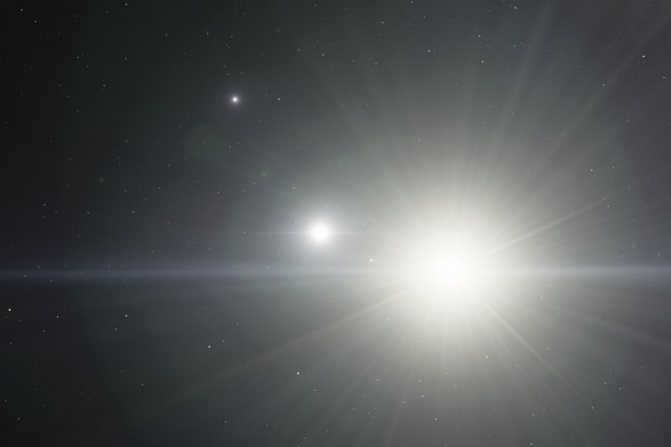
Discovered in 1779 by William Herschel, this celestial body is known for its yellowish white color. Interestingly, when observed through a telescope, it appears to have a greenish hue, which is actually an optical illusion. So, take a moment to admire this captivating pair – it truly is a sight to behold.
The third element of this particular system is located in close proximity to the central supergiant. This star, known as Polaris B, has a mass 1.26 times that of the Sun and completes one revolution every 30 years.
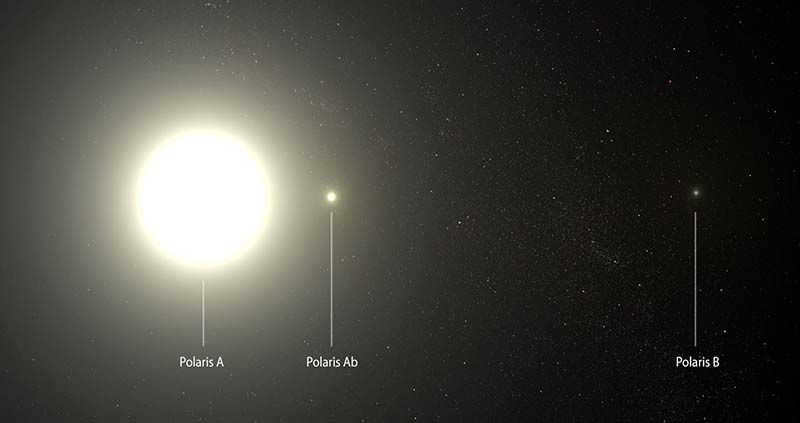
However, Polaris possesses an additional characteristic – it is classified as a variable star of the Cepheus delta category, specifically a Cepheid. Furthermore, it is the closest known Cepheid to our location. As a reminder, Cepheids are pulsating stars that consistently oscillate in brightness, resulting in periodic increases and decreases. Polaris, however, stands out as an atypical Cepheid due to its subdued pulsations. Its luminosity underwent much more significant fluctuations a century ago, but it has since become noticeably more radiant.
Additionally, check out: What steps should you take if a thunderstorm catches you indoors, outdoors, in the woods, by a body of water, in a vehicle, or in an open field.
Polaris is famous for its proximity to the North Pole. However, it has not always been in this position and will not remain so in the future. Due to the Earth’s axis precession, other stars will eventually take its place as the closest to the pole. In the year 2102, Polaris will no longer hold this title and will be further away from the pole. By the year 3200, Cepheus gamma will be the star closest to the pole, and in 13000, it will be Vega, the alpha star of Lyra. Interestingly, Vega was already a polar star in 13000 BC.
Yildun is the delta of the Little Bear
This celestial object is known as Yildun and it represents the delta (δ) star in the constellation Ursa Minor, also known as the Little Bear. Yildun is relatively young, with an estimated age of approximately 170 million years. It possesses a high surface temperature of 9900 K, classifying it as a white dwarf. Despite its compact size, Yildun has a radius 2.8 times larger than that of our Sun. In terms of distance, Yildun is relatively close to our solar system, situated approximately 172 light years away.
Due to its fast rotation, Yildun is expected to exhibit noticeable flattening at its poles. In the future, Yildun will undergo a transformation into a red giant, a fate shared by our own Sun, albeit on a much longer timescale. As Yildun approaches our solar system, it will gradually grow brighter and more prominent in our night sky.
Urodelus is the epsilon star in the constellation of Ursa Minor.
This particular celestial object is actually a binary star system. The primary star in this system is an orange giant, which is 19 times larger than the Sun and three times more massive. It emits 225 times more light than the Sun, even though its temperature is nearly identical, owing to its significantly larger surface area.
The secondary star in this binary system has not been extensively studied. It is known to be a white main-sequence star that completes an orbit around the primary star every 39.5 days. This indicates that the two stars are in close proximity. Due to the smaller star periodically eclipsing the larger one, the overall brightness of the system fluctuates. As a result, Urodelus is classified as an Algol-type variable star.
The distance to this binary star system is approximately 300 light-years, and it is gradually approaching us at a rate of 10.5 km per second.
Alifa is the brightest star in the Little Dipper constellation.
Alifa is a hot white star with a surface temperature of approximately 9000 K. It is significantly larger than the Sun, measuring six times its size, and it emits 191 times more light than our Sun. Alifa is located at a distance of 337 light years from Earth, which is why it appears as a faint star in our sky with a brightness of only 4.2m.
Allaso is one of the stars in the constellation Ursa Minor
This particular star is also known by another popular name – Anwar al Farkadin. When observed in the night sky, it appears as an ordinary star with a brightness of 4.95m. Its distance from Earth is approximately 96 light years.
Upon closer examination, it becomes evident that Allaso is actually a binary star system. The primary star in this system is a white-yellow dwarf, which is nearly twice the size of our Sun and 1.66 times more massive. It also has a slightly higher temperature. This is the star we see when we look up at the sky.
The second component of this system, however, is not well understood. It is classified as a red dwarf and is located 13 light-years away from the main star. Although this may seem like a considerable distance, gravitational interactions between the two stars are still possible at such separations.
The orange giant, Kohab, is the second brightest star in the constellation. It is 42 times larger than the Sun and 2.5 times heavier. If placed at the center of the solar system, Kohab would emit 400 times more light than the Sun, resulting in a devastating amount of radiation that would incinerate everything.
Kohab has a satellite that is yellow-orange in color and has a brightness of 11.3. It can be detected at an angular distance of 3.4 seconds from Kohab.
In 2014, scientists discovered an exoplanet in Kohab that is 6 times more massive than Jupiter. This planet has a maximum distance from the star of only 1.4 astronomical units and completes a full revolution in 522 days. Due to the size and power of Kohab, this exoplanet can be classified as a “hot Jupiter.”
Ferkad: The Gamma Star of the Little Dipper
Ferkad is a fairly average white giant star that belongs to the Little Dipper constellation. It is about 15 times larger and 8 times heavier than the Sun. Despite its ordinary nature, Ferkad emits a staggering 1100 times more light than the Sun, making it a prominent feature in the night sky with a brightness of around +3m. This is quite impressive considering the fact that Ferkad is located approximately 480 light years away from us.
What makes Ferkad even more interesting is that it is a variable star of the Delta Shield type. It undergoes periodic changes in brightness, varying by approximately 0.05m over a period of 3.43 hours. These changes are caused by pulsations on the surface of the star, adding to its mystique and allure.
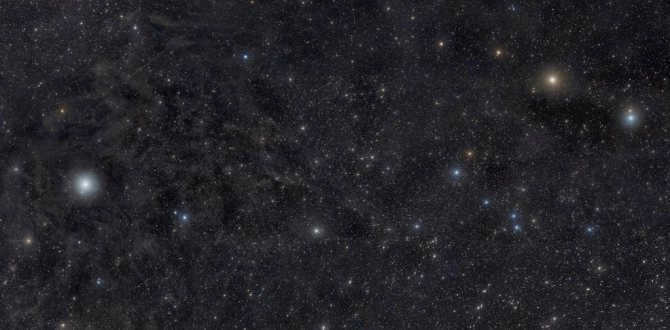
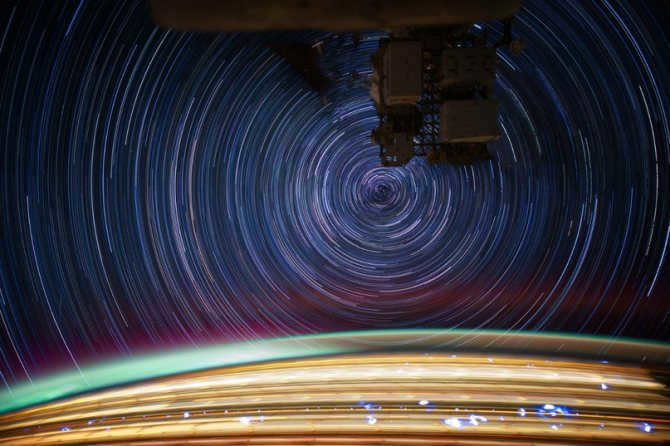
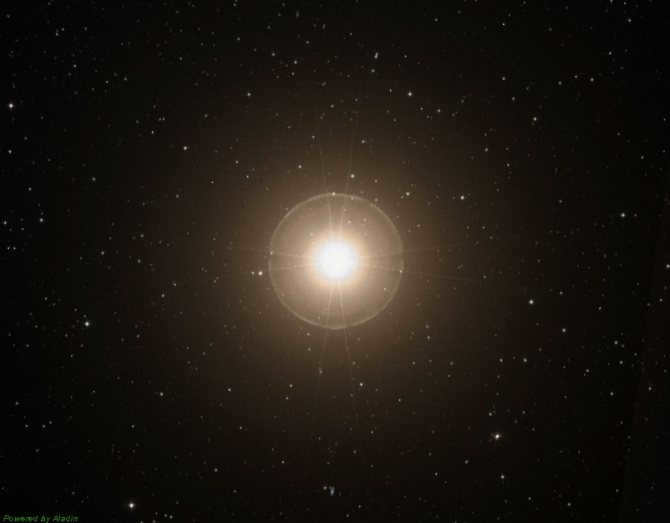
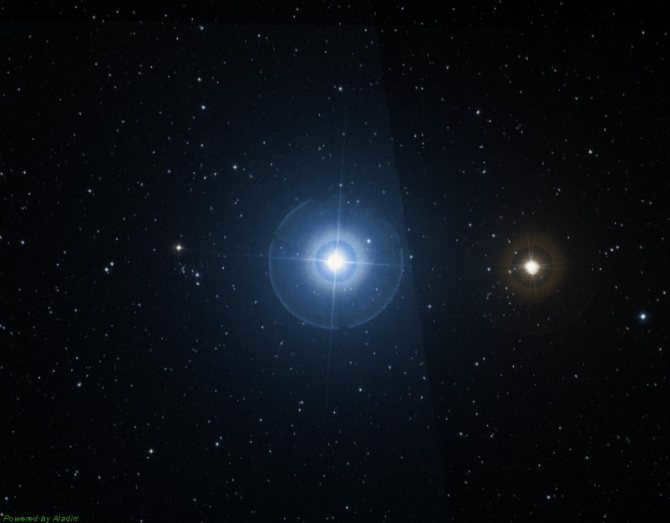
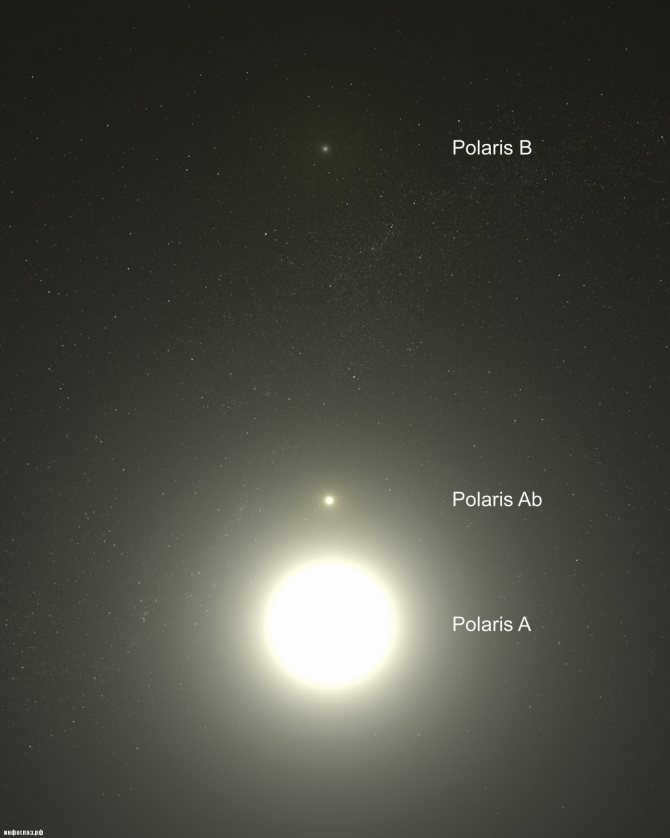
The popularity of Polaris is due to its close proximity to the North Pole. This star, located in the constellation of Ursa Minor, is only one degree away from it. By the year 2100, due to the precession of the Earth’s axis, it will come even closer, reaching a distance of half a degree. It appears to hang over the North Pole, making it a useful reference point for travelers in the past. By observing the height of Polaris above the horizon, travelers were able to determine their geographic latitude.
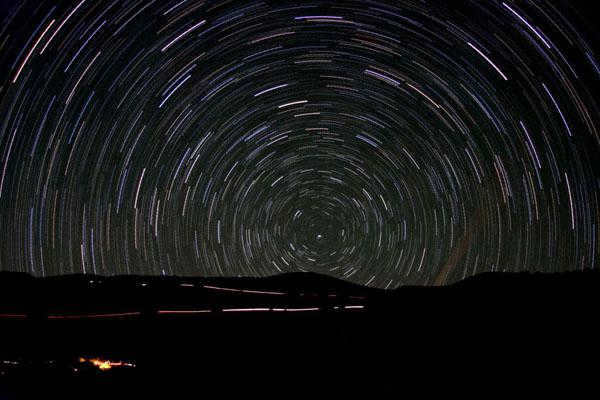
The point where the Earth’s axis extends is known as the North Pole. To an observer on Earth’s surface, the stars in this region appear to be stationary. Polaris has been the star around which the others revolve since around 1100. However, it will be replaced by a new star after 3200.
Galaxies in the Little Bear constellation
The Little Bear constellation offers limited options for amateur stargazers. The only galaxy present in this constellation is a dwarf elliptical galaxy, commonly known as the Little Bear.
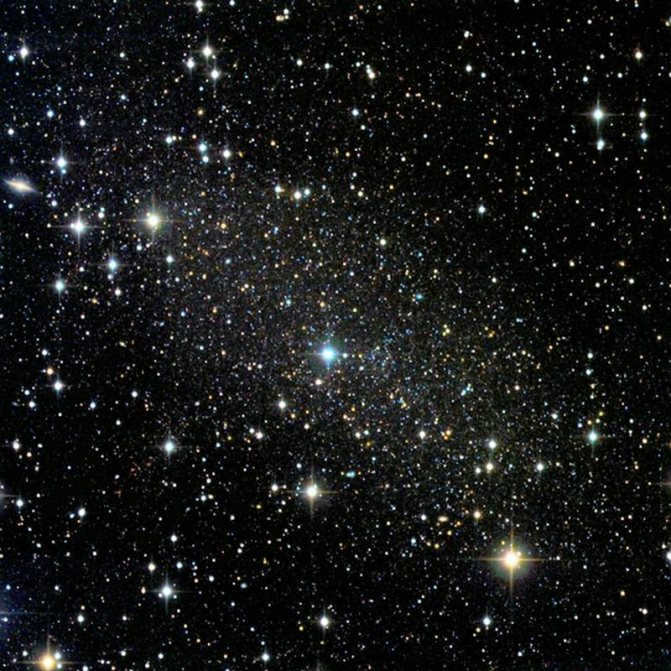
The galaxy known as the Little Dipper is composed of ancient stars, with star formation occurring approximately 14 billion years ago and lasting for a period of 2 billion years. Following this initial burst of star creation, subsequent star formation in the Little Dipper has been minimal.
Similar to the Magellanic Clouds, the Little Dipper Galaxy is considered a satellite of our own Milky Way.
The night sky map’s visual representation
Throughout history, humans have marveled at the magnificent night sky, adorned with countless sparkling stars. It is likely that even early “astronomers,” in their quest to comprehend what they beheld, discovered that most stars belonged to distinct groups that could shift in the sky and occasionally disappear beyond the horizon, only to reappear in due course. These groups were bestowed with various names, ranging from animals and mythical creatures to legendary heroes and even everyday objects. Diverse cultures developed distinct systems for naming these star clusters—ancient Chinese scientists, for instance, referred to them by the names of imperial palaces or their respective rooms. Nonetheless, the familiar names of the 48 constellations visible in the night sky of the Northern Hemisphere are primarily attributed to the ancient cultures of Europe and the Middle East. Another 40 star groups have been identified since the 16th century; however, nearly all of them are visible solely in the Southern Hemisphere, rendering them unknown to the ancient Greeks, Romans, and Arabs.
Meteor showers in Ursa Minor
Ursa Minor is home to a single meteor shower known as the Ursids. This shower occurs annually from December 17 and lasts for approximately one week. The peak of activity usually occurs on December 22, during which observers can expect to see around 10 meteors per hour. However, there have been instances where the Ursids have experienced a significant increase in activity. In 1945, for instance, the shower produced an impressive 120 meteors per hour.
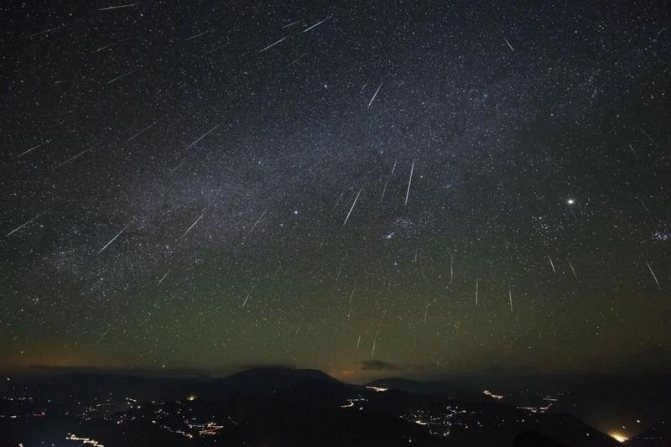
The Ursids meteor shower is caused by the comet Tuttle, which was originally discovered by Pierre Mechene in 1790. This comet completes a full orbit around the sun approximately every 14 years.
The constellation of Ursa Minor, also known as the Little Bear, is always visible in the night sky. While it may not have as many prominent features as other constellations, it is still worth locating and observing its stars. Don’t forget to point out Polaris, the North Star, to your children!

How to locate the constellation Ursa Minor through Polaris
This renowned celestial body is not the most luminous in the firmament, hence it is advisable to identify it through Ursa Major, which bears a resemblance to a colossal spoon. The constellation becomes discernible during clear nights – in autumn and winter it is positioned in the northern region of the sky, in spring it can be spotted in the east with an erect orientation – handle facing downward, and in summer – in the west, handle facing upward.
- By implementing our suggestions, locate Ursa Major in the sky. Mentally connect all the stars with a line – this will form a bucket with a handle.
- Pay attention to the cluster of stars that form the bowl, consisting of 4 stars. The outermost stars, Dubhe and Merak, will enable you to determine the position of Polaris.
- Use an imaginary ray to connect Merak and Dubhe. Extend it upward and slightly to the right, a distance that is more than five times the distance between these stars. At the end of the line, you will find Polaris, which marks the end point of the handle of the Little Dipper.
If you still can’t visualize the Little Dipper after this exploration, here’s a hint:
There are a number of constellations that are quite distinct. Some are familiar to everyone, while others are known only to a few. However, there is a group of stars in the night sky that is universally recognized. This article will explore the positioning of the Big Dipper and the Little Dipper. Constellations are often associated with numerous myths and legends, some of which will also be discussed. Additionally, we will highlight the most renowned and brilliant stars that can be observed within this widely recognized cluster.
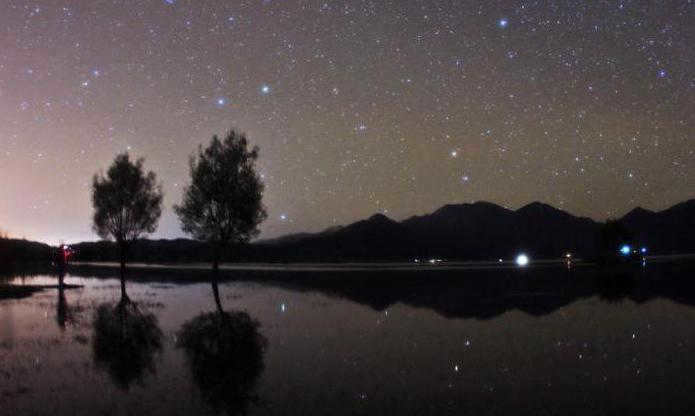
The celestial canopy, the constellation Ursa Major, the constellation Ursa Minor, Andromeda, the Crux… What could be more captivating and grandiose? Countless celestial bodies radiate and twinkle, captivating inquisitive minds. Humanity has forever sought its celestial abode, pondering the mechanics of the cosmos, its place within it, whether it was fashioned by deities or if it itself is a divine being. Nestled beside a crackling fire, gazing up at the distant expanse, individuals have come to realize a fundamental truth – the stars are not haphazardly strewn across the firmament. They possess their rightful positions.
Each night, the positions of the stars remained unchanged. Nowadays, it is common knowledge that stars are located at various distances from Earth. However, when gazing up at the sky, it is impossible to discern which stars are farther away and which are closer. In the past, our ancestors could only differentiate them based on the intensity of their luminosity. They identified a small portion of the brightest stars and organized them into distinct shapes, naming them constellations. In contemporary astrology, there are a total of 88 constellations in the celestial sphere. Our ancestors were only familiar with approximately 50 of them.
The constellations had various names associated with objects (such as Libra, Southern Cross, Triangle). The luminaries were named after heroes from Greek mythology (such as Andromeda, Perseus, Cassiopeia), while the stars were given names of both real and fictional animals (such as Lion, Dragon, Big and Little Dippers). In ancient times, people showcased their vivid imagination when it came to naming celestial bodies, and it is not surprising that these names have remained unchanged to this day.
The Bucket Cluster: A Unique Formation in the Night Sky
When it comes to star clusters in the northern hemisphere, none are as famous and easily recognizable as the constellations of the Big Dipper and the Little Dipper. These clusters, known for their distinctive shape and well-established names, have captured the imaginations of people since childhood. Standing as the third largest cluster of stars, they hold a special place in our hearts.
While constellations like Virgo and Hydra take the top spots in terms of size, the Big Dipper holds its own with a total of 125 stars. What makes this cluster truly remarkable is that all of these stars can be seen with the naked eye. Within this cluster, seven of the brightest stars come together to form the iconic shape of a dipper. Each of these stars carries its own unique name, adding to the allure and fascination of the bucket-shaped formation in the night sky.
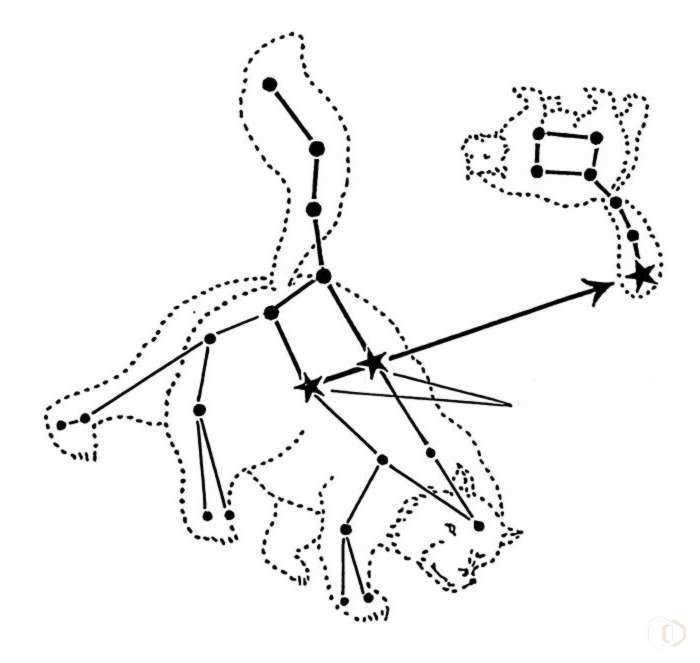
Let’s shift our focus to the constellation known as the Ursa Major. It is inconceivable to envision the realm of outer space without this awe-inspiring formation. Within the celestial members of this cluster, we can discern:
- Dubhe – signifying the term “ursus” or bear. This particular star stands out as the most luminous within the Ursa Major.
- Merak – holding the distinction of being the second brightest star in the constellation. It signifies “lumbi” or loins.
- Fekda – denoting “femur” or thigh.
- Megretz – translating to “initium caudae” or the commencement of the tail.
- Aliot – symbolizing “lac coagulatum” or curd.
- Mitzar – corresponding to “subligaculum” or loincloth.
- Benetnash – quite literally rendered as “dux lugentium” or leader of the mourners.
These are merely a few examples of the stellar constituents that constitute the renowned cluster.
As the constellation traverses the celestial sphere.
Locating the Big Dipper and Little Dipper constellations in the night sky is a relatively simple task. The best time to observe them is during the months of March and April. During these refreshing spring evenings, the Big Dipper can be found directly overhead, shining brightly in the heavens. However, as April progresses, the cluster of stars begins to shift towards the western horizon. Throughout the summer months, the constellation leisurely moves towards the northwest. By late August, the dipper can be spotted low in the northern sky, where it will remain until the arrival of winter. As winter sets in, the Big Dipper once again rises above the horizon, commencing its journey from north to northeast.
Adjust the position of the stars based on the time of day
Focus on how the arrangement of the constellations of the Big and Little Dipper alters throughout the day. For instance, during the nighttime in February, we observe the handle of the bucket pointing downward in the northeast, but by morning, the constellation will shift to the northwest. By doing so, the handle will turn upward.
Interestingly, the five stars within the bucket form a distinct cluster and move independently from the other two stars. Dubhe and Benetnash are gradually moving in the opposite direction from the other five stars. Consequently, in the near future, the dipper will assume a completely different appearance. However, we will not witness this transformation, as the significant change will become noticeable in approximately one hundred thousand years.
The enigma of the celestial duo Mizar and Alcor
Within the constellation of the Big Dipper lies a captivating binary star system – Mizar and Alcor. What makes it so intriguing? In ancient times, these twin stars served as a test for the keenness of human vision. Mizar, a star of moderate size, resides within the bucket of the Big Dipper, while Alcor, its faint companion, is barely discernible. An individual with exceptional eyesight will effortlessly distinguish these two stars, while someone with impaired vision will perceive them as a solitary luminous speck in the night sky. However, these celestial entities harbor a couple of other astonishing enigmas.
The naked eye is unable to perceive the inherent peculiarities within them. When a telescope is aimed at Mizar, it reveals the presence of two stars instead of just one, which are referred to as Mizar A and Mizar B. However, there is more to it. Spectral analysis has unveiled that Mizar A is composed of two stars, while Mizar B is composed of three stars. Regrettably, these celestial bodies are situated at such a distance from Earth that no optical instruments can reach them to fully unveil their secrets.
Stars originating from the Ursa Minor cluster
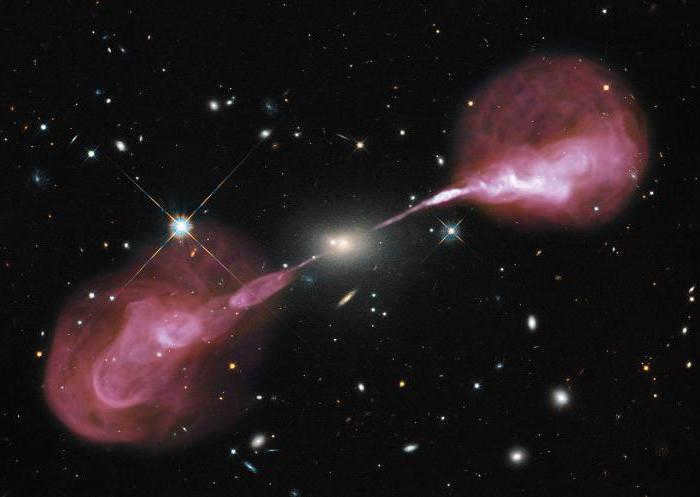
The two stars in the Big Dipper are also known as the Pointers. Merak and Dubhe earned this nickname because if we draw a straight line through them, we will reach the North Star from the constellation of Ursa Minor. This group of stars is also referred to as near-polar. The constellation of Ursa Minor consists of 25 stars, all visible to the naked eye. It is worth noting the most popular and brightest ones.
One of the notable stars is Cohab, which served as a navigational reference point for sailors from 3000 B.C. to 600 A.D. Polaris, also known as the North Star, indicates the direction to the North Pole. Other famous stars in the cluster include Fercadus and Yildun.
For a significant period, there was a lack of consensus on the name
The constellation known as the Little Bear bears a resemblance to a dipper, similar to the well-known Big Dipper. The Phoenicians, who were renowned navigators in ancient times, used this group of stars for navigation purposes. However, Greek sailors relied more on the Big Dipper for orientation. The Arabs perceived the Little Dipper as a rider, while the Indians saw it as a monkey that clings to the center of the world with its tail and orbits around it. As we can observe, there was a prolonged absence of universal agreement on the meaning and name of this constellation, with each nation interpreting the starry sky in a distinct, relatable, and easily understandable manner. What other insights can the constellation of the Big Dipper provide about itself?
Mythical Stories Surrounding the Constellation. The Star Dubhe
The constellation known as the Big Dipper and the Little Dipper has long been the subject of numerous legends and tales.
One popular belief centers around the brightest star in the Big Dipper constellation, Dubhe. According to the story, Callisto, the beautiful daughter of King Lycaon, served as one of the huntresses for the goddess Artemis. Callisto captured the attention of the mighty Zeus, who fell madly in love with her. Their union resulted in the birth of a son named Arkas.
However, Zeus’ jealous wife, Hera, discovered the affair and sought revenge. In a fit of rage, she transformed Callisto into a bear. Years later, when Arkas grew into a skilled hunter, he unknowingly stumbled upon his mother in bear form. Ready to strike her with an arrow, Zeus intervened and prevented the killing. Instead, he transformed Arkas into a smaller bear and placed both mother and son in the night sky, ensuring they would forever remain together for all to see.
The tale of the tiny group of celestial bodies
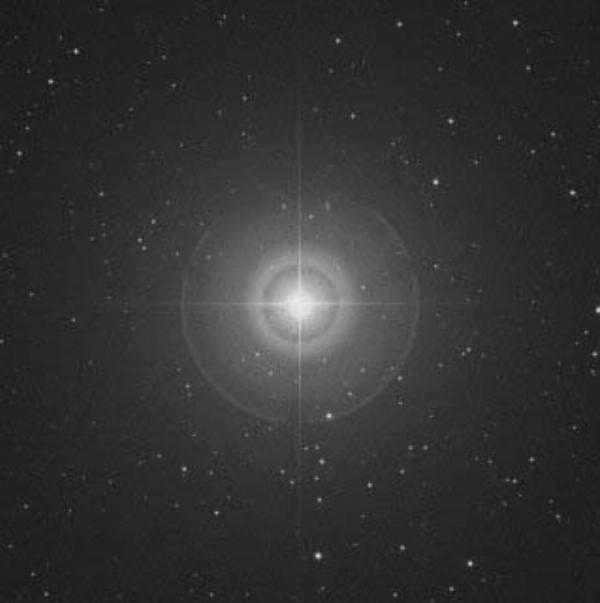
There exists a tale about the constellation known as the Little Bear. The story goes like this. In order to save her son Zeus from his father Cronus, the Greek god notorious for consuming his own offspring, Rhea, his wife, managed to snatch away a small child and hide him in the caves. Along with the help of a goat, the baby was nourished by two nymphs named Melissa and Helis. As a reward for their assistance, Zeus, upon ascending to the position of ruler of the skies, transformed them into bears and placed them among the stars.
Feeling hopeless, Eriulok journeyed to the Arctic Ocean and invoked the goddess Arnarkuachssak, who ruled over the depths of the sea. He shared his story and troubles with her. The goddess offered her assistance on the condition that Eriulok fetch her a ladle filled with magical berries that would restore her youth. Accepting the terms, the hunter set off to a distant island where he discovered a cave guarded by a bear. After enduring great hardship, he managed to lull the forest creature to sleep and pilfered the ladle containing the berries. True to her word, the goddess rewarded the hunter with a wife, and in return, he received the magic berries. Following all his adventures, Eriulok wedded and became the proud father of a large family, the object of envy among his neighbors. As for the goddess, she devoured all the berries, regaining a couple of centuries of youthfulness, and in her elation, flung the empty ladle into the sky, where it became entangled with something and remained suspended.
A heartwarming tale of righteousness and wickedness
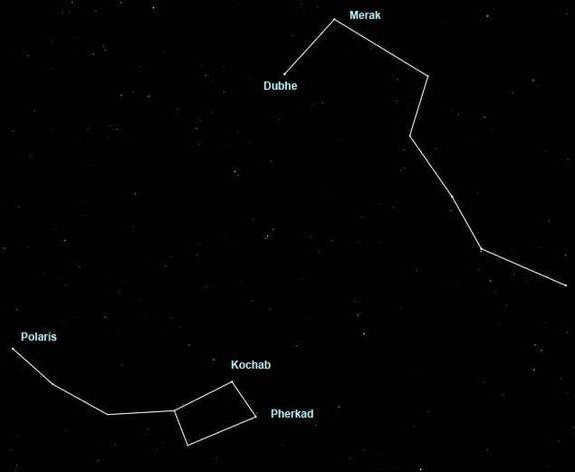
The aura of enigma has dissipated due to advancements
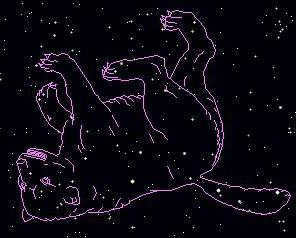
Just as in ancient times, so in the present day, constellations continue to serve as guides in the vastness of space. Explorers and seafarers can rely on the brightness and positioning of these constellations to determine the time, find their way, and more. In our modern era, we may not gather around the campfire as often or gaze up at the mystifying, star-filled sky, nor do we create legends about the Big and Little Dippers, Cassiopeia, and Hound Dogs as frequently. Few individuals possess the knowledge to point out the Big and Little Dipper constellations. From our lessons in astronomy, we understand that stars are incredibly distant and that many of them are actually planets akin to our own Sun.
Summary
